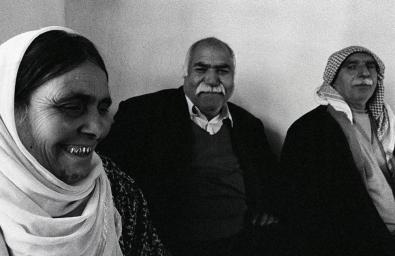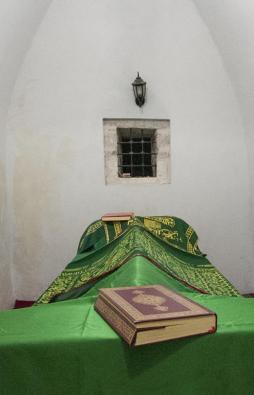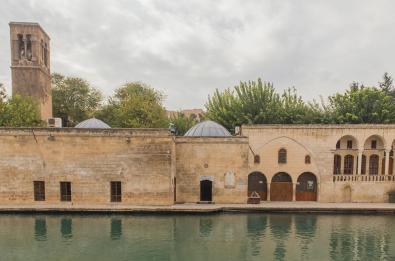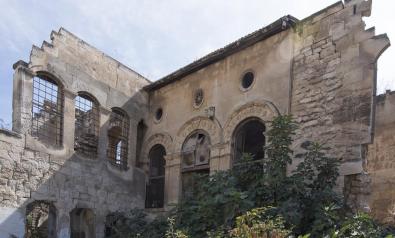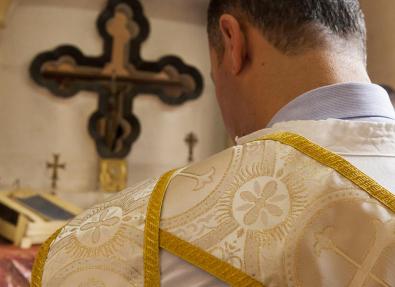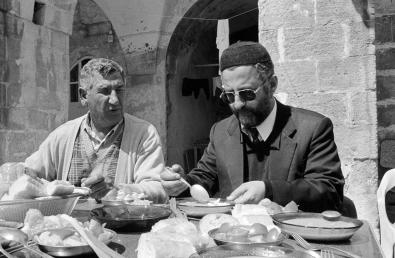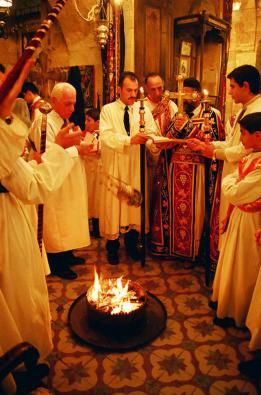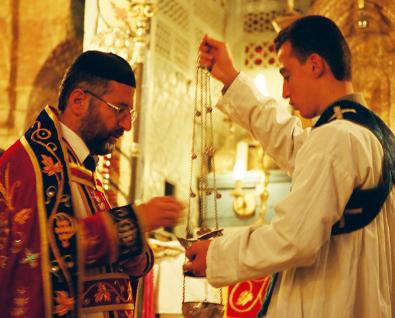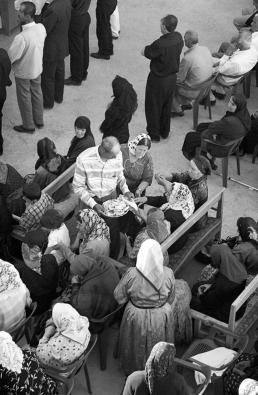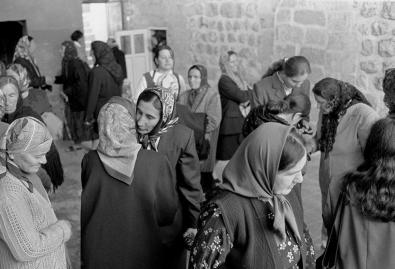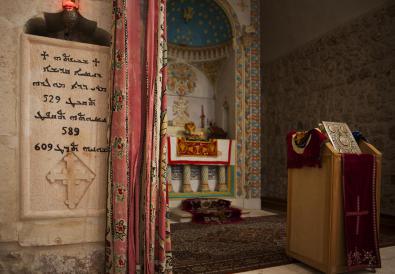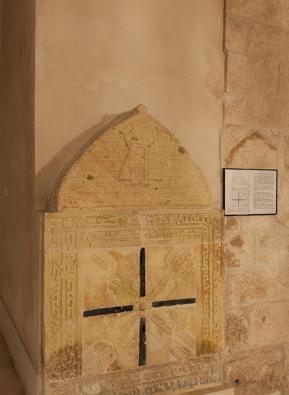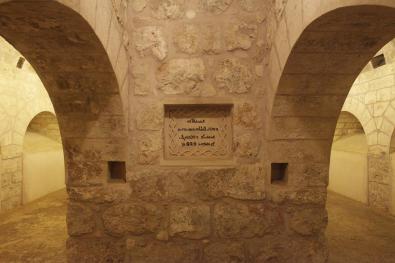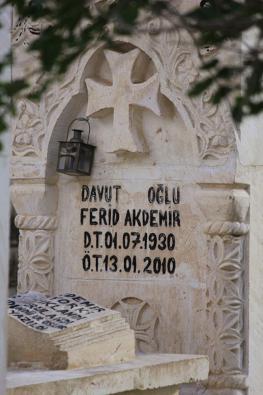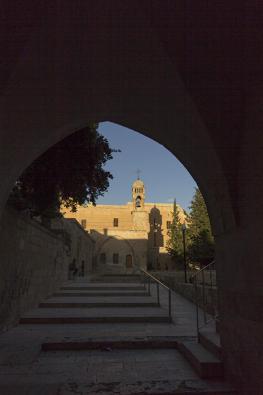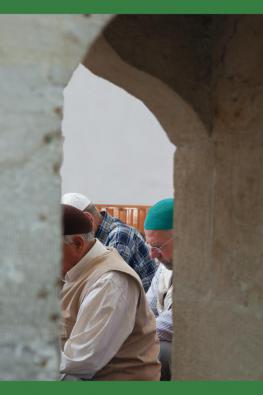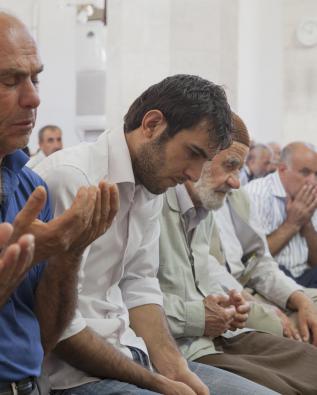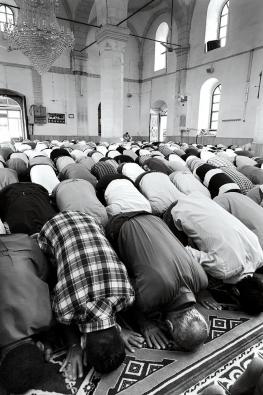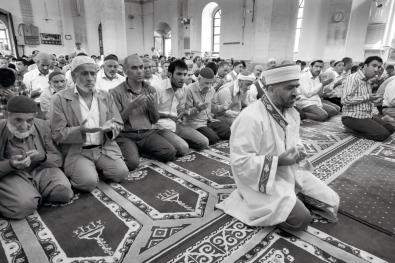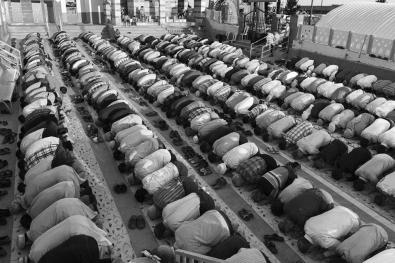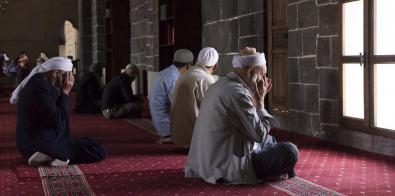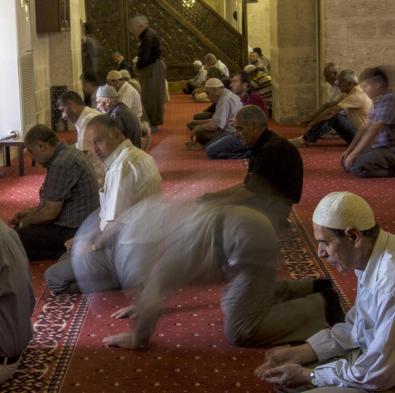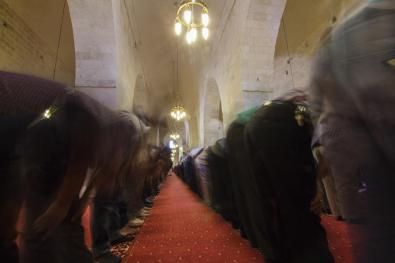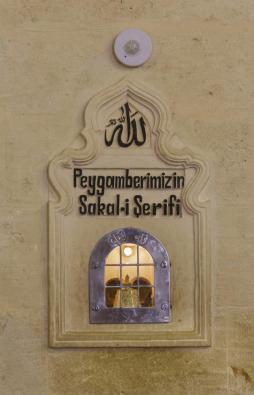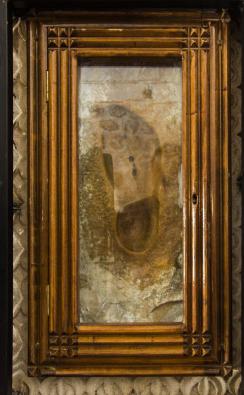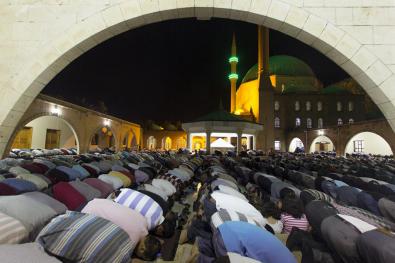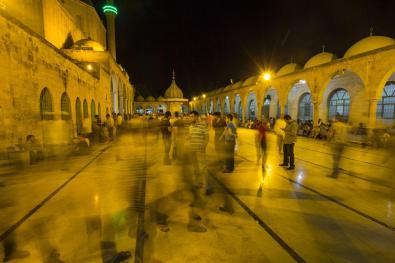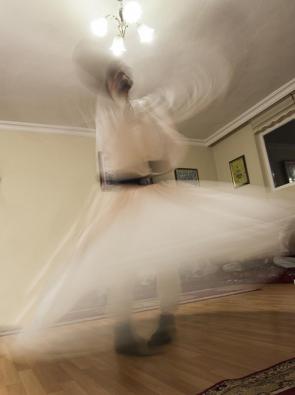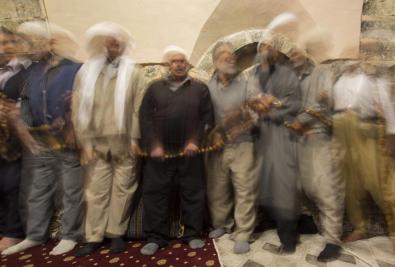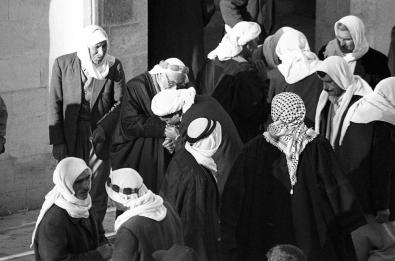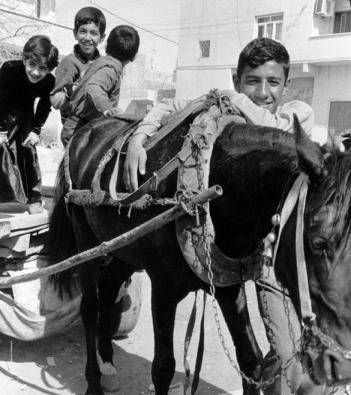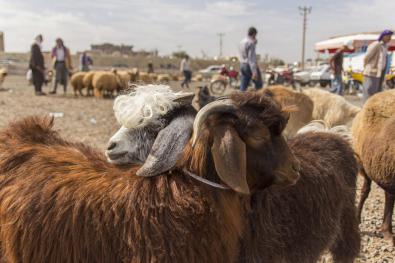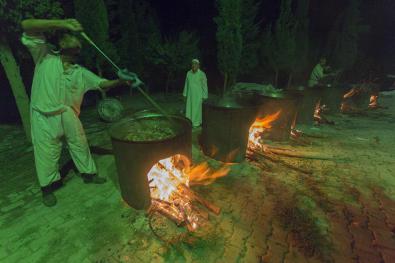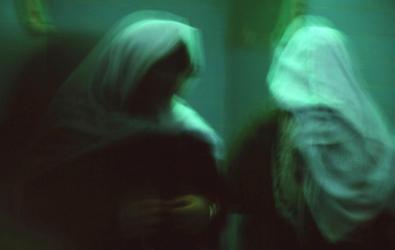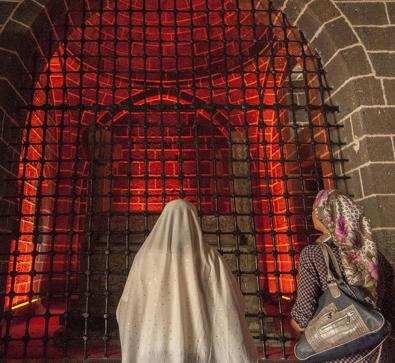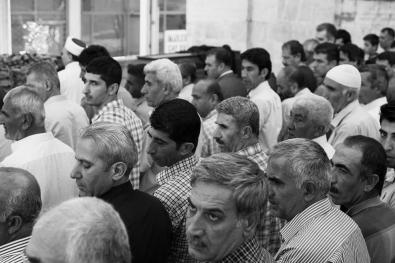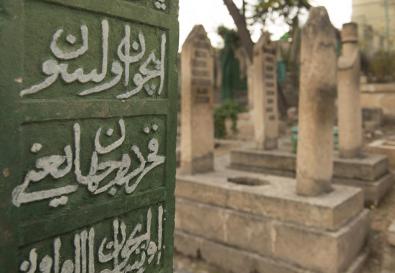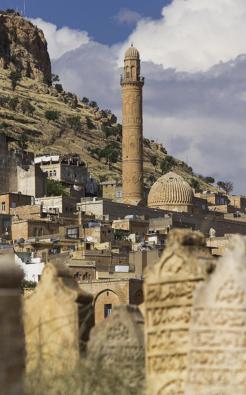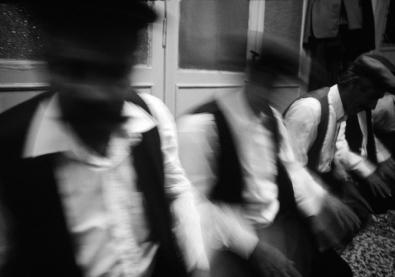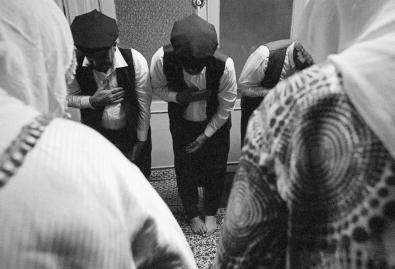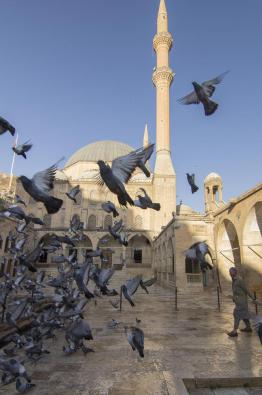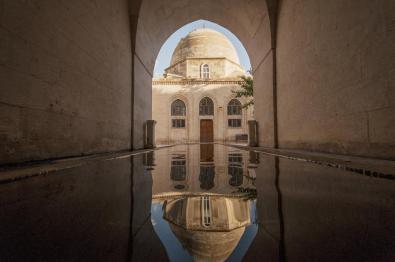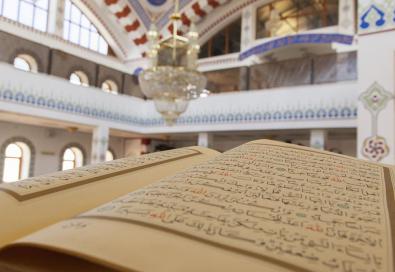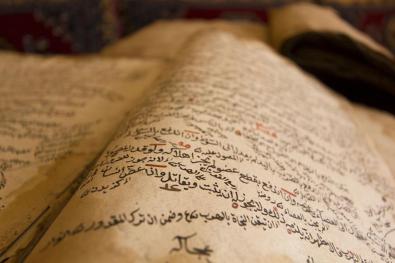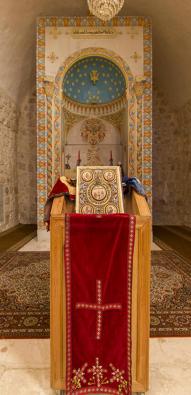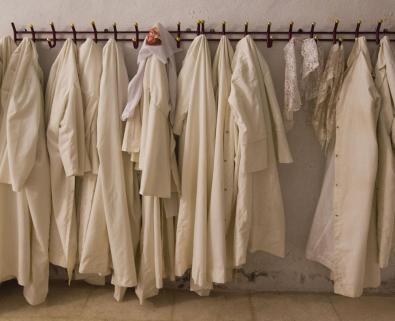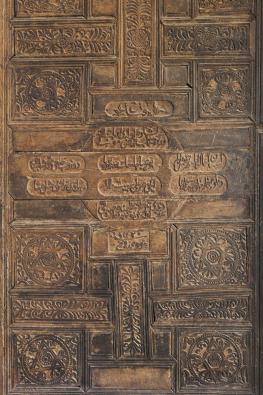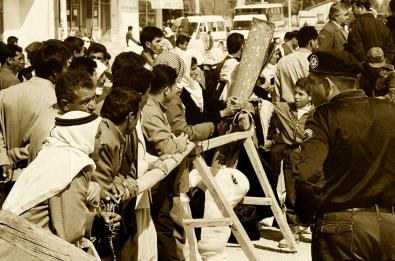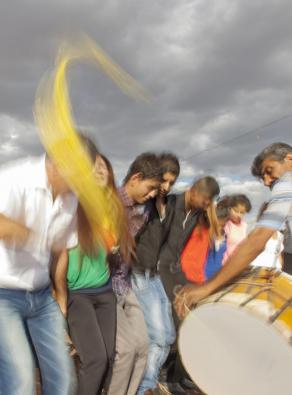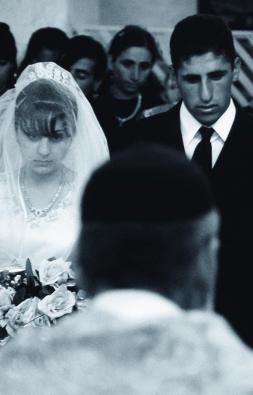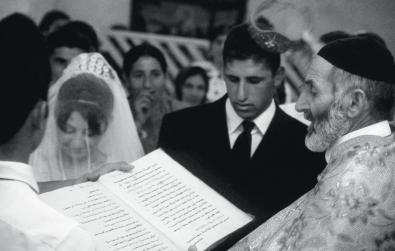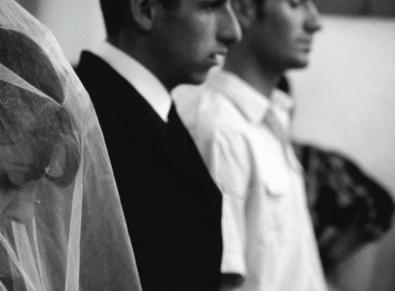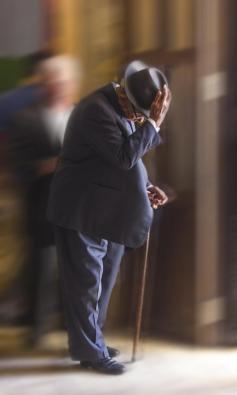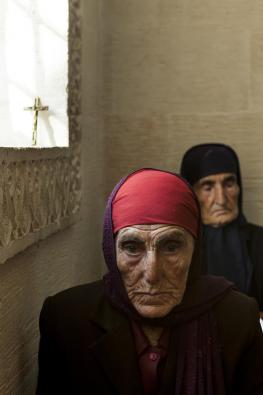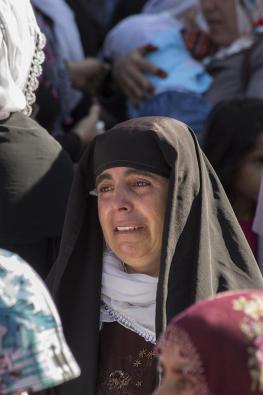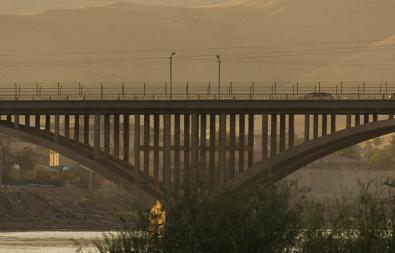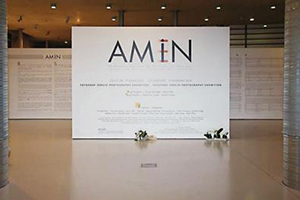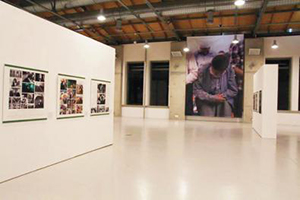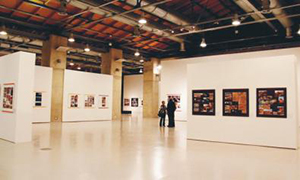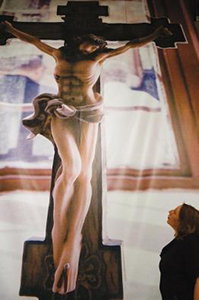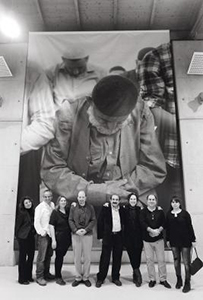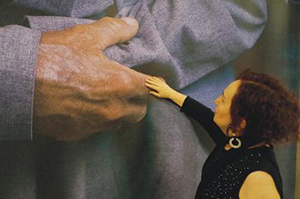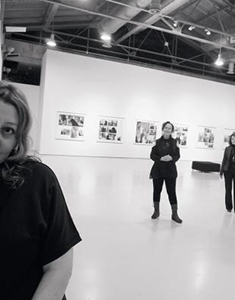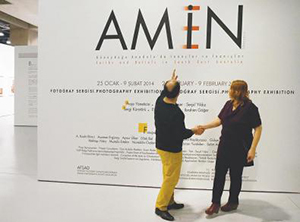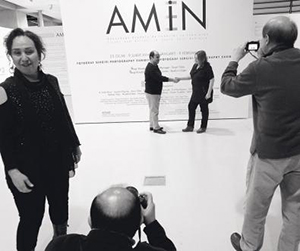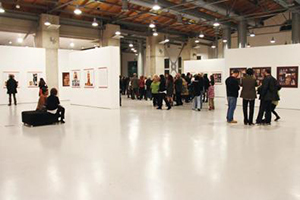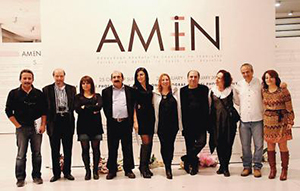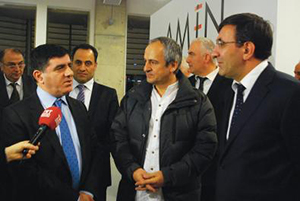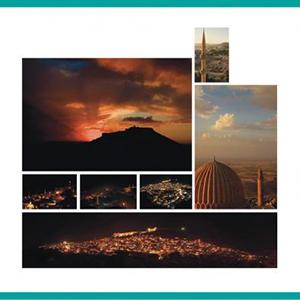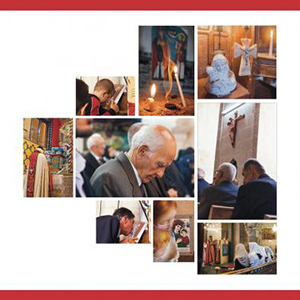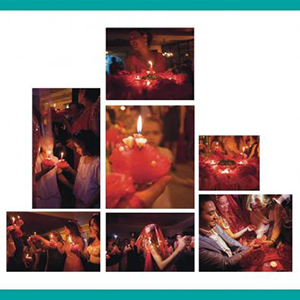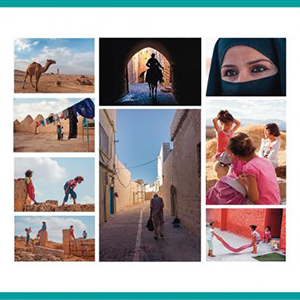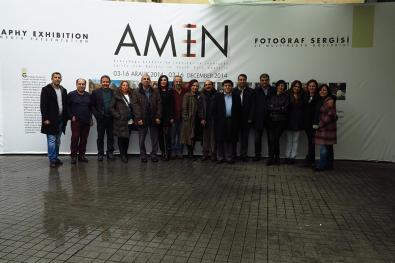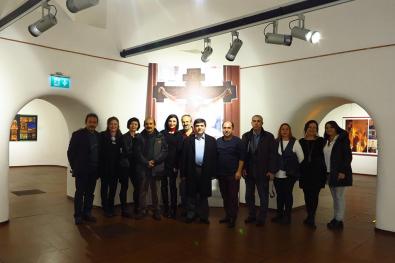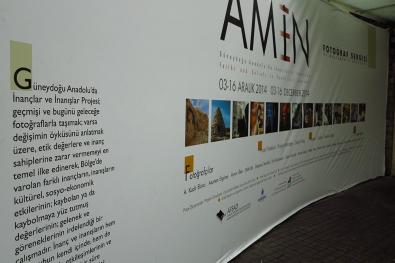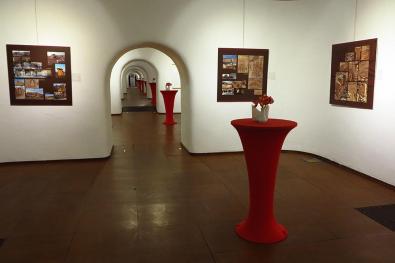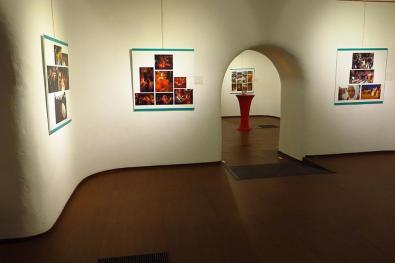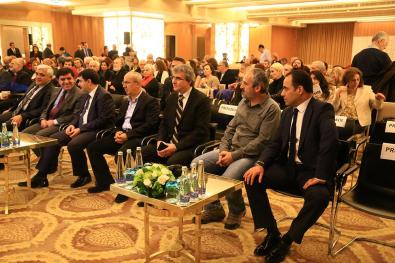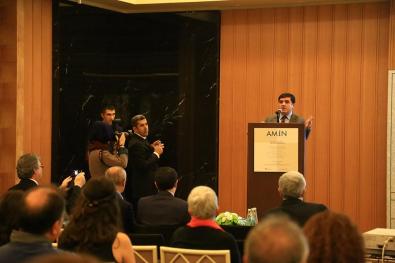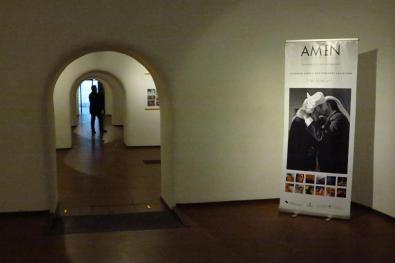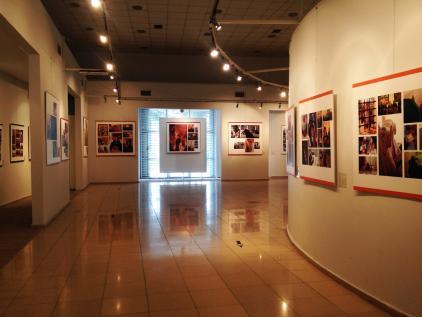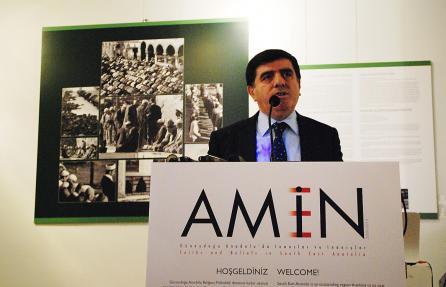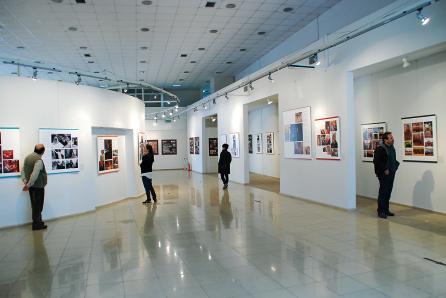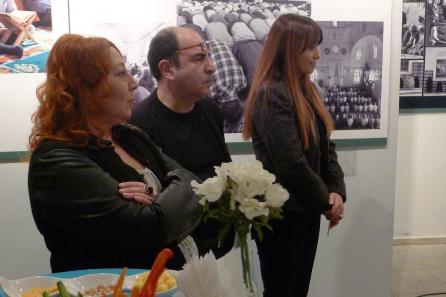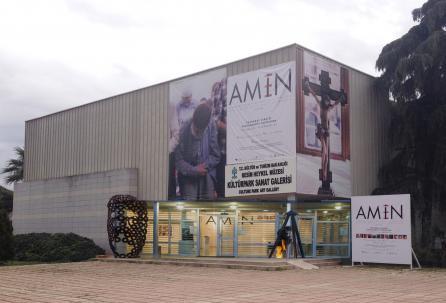Starting from the second quarter of the 20th century, projects combining land and water were launched in the region of Southeastern Anatolia. The region and its people were destined to face an inevitable change when giant projects through which land eventually met with water.
Now, with the intuition of a photographer, the AFSAD voluntarily followed this great change. The photographing of change started first in 1989 when the foundations of Urfa Tunnels were laid. The title of its first work was “Longing for Water”. Then there was five years of waiting for a visible change. Tunnels were completed and irrigation canals brought water to land and its people. It was right at that moment, in 1995 that the roads of AFSAD and GAP Regional Development Administration crossed. The region was photographed by projects that followed each other: “A Tale of Euphrates”, “Our Word is on GAP”, “Women and Children in GAP”, “Life Merging to Euphrates, Euphrates Merging the Life”, “Ten Years of Accumulation in GAP”… Change, socioeconomic structure, etc. the region was almost entirely photographed with its so many aspects.
The region of Southeastern Anatolia is also extremely rich in terms of faith with its culture dating back to the depths of history. The “Faiths and Beliefs in South East Anatolia” was a project launched to document this richness and common culture. With over seventeen shooting tours in the region, the project continued between 2000 to 2013. Fifteen photographers from AFSAD worked voluntarily.
Now visitors can see at the exhibition hall 758 photographs selected from a large archive of thousands of photographs. The album has 825 photographs.
“Ten Years of Accumulation at GAP (Southeastern Anatolia Project)” photo exhibition had just ended at the end of 1999. As the entire world was getting ready to celebrate the 2000th anniversary of the birth of Christ, many preparations were also being made in Turkey under the name of “Faith Tourism”. At the time, AFSAD (Ankara Photography Artists’ Association) had tackled the Southeastern Anatolia Region with its projects of various themes spanning over 11 years, had realized six exhibitions, had seized the opportunity to better get to know the Region and its people, and to observe regional dynamics. During this entire work, the diversity of faith and belief in the Region was truly very interesting. As an idea born of the
catchphrase “Faith Tourism”, AFSAD could also re-handle the Region in terms of its faiths and beliefs. I shared this thought first with the AFSAD Executive Board, chaired by Alparslan Aydın back then, and later on with the GAP Administration. Then our work began in June 2000.
Faith… The most private, most tender, most untouchable world of feeling and living of man… To photograph it when even to approach it and to utter a few words on it is extremely difficult!.. The overall perturbation and vulnerability experienced at the Region at that time was another factor.
Nevertheless we set forth.
Since the matter at hand was faiths and beliefs, the method to be employed had to be different than those that had already been adopted in all other projects to date. The first order of business was to build a core team made up of our experienced members who had participated in previous projects carried out in the Region. Afterwards, for nine weeks we held many meetings in which the acquired information was evaluated parallel to efforts at oral and written resource review, information acquisition and the saturation of information. We had contacted the Turkish History Foundation for resource review. The book “Religions-Congregation-Tribe, Mardin” by the Turkish History Foundation was published in August 2000. We were lucky! We were informed in advance, and had already met its authors. Suavi Aydın, Süha Ünsal, Oktay Özel among the authors, and Oya Açıkalın Rashem who we had collaborated with for the “Life Merging to Euphrates, Euphrates Merging to Life ” Project had joined our meetings a couple of times, Associate Professor of Sociology Rashem, Professor of Social Anthropology Aydın and historian Ünsal had become project advisors and the foundation for the second phase of the project was laid. And thus, perhaps for the first time in our country, a documentary photographic project was to be carried out with the accompaniment of and contribution from experts starting from the developmental stage.
The last thing to do for the first phase was to make an official application to the GAP Administration- which happened in August 1st, 2000.
The second phase of the Project was field research. The specification of groups of faith in the Region, getting in touch with people among these groups; the scanning of shooting venues; forming relations with people in these venues; learning about the special days for different faiths; composing shooting plans were the main headlines. The research team, which I was also a part of, was composed of Özcan Yurdalan and three advisors who would locally transmit their experiences related to the Region and ensure communication. The trip began in 30 November 2000. Accompanied by Suavi Aydın in Gaziantep and Şanlıurfa; Özcan Yurdalan in Adıyaman and Diyarbakır; Süha Ünsal in Diyarbakır, Mardin and Şırnak, and in addition to the stated provinces in Batman, Siirt and once more Şanlıurfa, Oya Açıkalın Rashem and I worked together until 18 December 2000 (we were not able to include Kilis in this research). In addition to connections established with acquaintances, in some places new doors were opened, we were able to reach
people of different groups. We gave lengthy accounts of our aim and purpose to everyone we met. Do not assume that we were immediately welcomed by everyone! During the course of time, we repeatedly knocked on certain doors. Sometimes we were guests at their homes, at times we even lodged there! Overtime, friendships grew bigger. Still, until today we have not managed to capture a single photograph of their religious practices… On the other hand, photo shootings during field research were not planned; but both Yurdalan and I had taken personal precautions and set out with plenty of film. Glad we did so! Some shootings could only be done just then.
The reports we were keeping with Rashem every single night and the evaluations we were carrying out did nurture the hope for the project to start, but we were still in a thick layer of mist! It was not possible to plan a long term workflow and to predict a termination date. Even if we did start, perhaps the project would never be concluded. It all depended heavily on how far the boundaries could extend, what and in which amount people would transfer to us, how they would share with us, and how much we would internalize those and how we would take them along. We had a single key in communication made up of impartiality-sincerity-integrity.
In case the research was concluded with an opinion in favor, the shooting teams had to be determined within a few days, the shooting schedule had to be arranged and new correspondence with the GAP Administration had to be exchanged, because the Yaldo Feast (Christmas- 25 December) and the Eid al-Fıtr (27 December) were in the last consecutive days of 2000. We had a very important opportunity ahead of us that had to be seized upon.
Both institutions were presented reports stating an opinion in favor. Initially, different teams that would work with each group of faith were planned, but this approach which excessively increased the budget was not accepted, instead; it was settled on the method that required me to personally accompany each shooting in order to maintain continuity in relations. And thus we took a step towards the third phase with the following principle, approach and goal:
“Setting out to carry the past and the present to the future through photographs and to tell the tale of change, if present, the Faiths and Beliefs in Southeastern Anatolia Project; adopting the non-harming of ethical values and the believers as the most fundamental principle, is a work in which the cultural and socio-economic effects of different existent faiths in the Region; values that are lost or that tend to be lost; traditions and customs are examined. It endeavors to produce the most unbiased section of the interaction and influence of faiths and beliefs both within each group and between different ones within a certain period of time by not allowing a mercenary or fictional understanding that would harm persons, rights and freedoms.
In the light of this principle, every photographer accepting to take part in the Project also accepts to comply with the following working approach:
Behavior and personal disputes that could damage established relations are to be avoided.
In all shootings inclusive of human subjects, people who do not give consent cannot be photographed despite being completely or partially unrecognizable, or even if their faces are not visible; no person can be manipulated or forced to get the intended photograph.
Behavior that could affect the spiritual environment arising especially during religious practice that could disrupt spontaneity, distract people and draw the attention on the photographer cannot be undertaken.
In places of worship, there can be no insistence on doing shootings during religious practice in areas for which permission has not been obtained in advance.
All shootings are done in the natural light of the environment, with material that will attract the least attention (if dispensable without even a tripod).
Until the end of the Project or unless otherwise announced, the photographs produced within the scope of this work cannot be used without the permission and approval of the project manager and the AFSAD Executive Board.”
“For AFSAD, there was a single aim of the Southeastern Anatolia Projects: To generate permanent, reliable, impartial visual documents; creating printed, internationally accessible source material that would carry the past not only to the present, but to the future.”
The shootings were realized in two ways. The first was being present in the Region and shooting on specific days like feasts on condition of communicating beforehand, which was relatively easy. The second included rituals, ceremonies and activities with dates not known in advance which we could only join upon invitation, and was the genuinely time consuming part of the Project. Each time we were in the region we were recounting the ceremonies we wanted to participate in. Still, hearing sentences like “Oh, if only you had come two days ago, you missed a wedding!” and responding “But you were supposed to inform us!” became the usual talk after some time. It would be greatly unjust to say we were never invited. Sometimes, forgetting we were residing in Ankara, we received invitations to ceremonies that would be held in a few hours or in the evening. We all had our professional lives in different fields. If it was not for the times of mutual coherence in order to attend such ceremonies, the project work could still be continuing…
When after March 2002, the GAP Administration quit from project partnership for various reasons. During this period the project came to a partial standstill. However, we found it contradictory to our social responsibility to end the Project at a time when the shootings were not complete on a required level, the people of the Region had warmed up to us, and more importantly the promise of an exhibition and an album to the people we had photographed was unfulfilled. We continued further with the moral support given by the AFSAD Executive Boards chaired by Gülser Günaydın. This is what that meant: “By covering all expenses themselves, the photographers can work in the Region.” And we did so. We continued to participate in the invitations we received. We tried to benefit from vacation possibilities by taking them in the Region. Those who worked in this way were quite small in number. Time was flying by, and we were not reaching our desired level. In 2004, we started searching for sponsors both to finalize incomplete shootings and to fulfill the
given promise of an exhibition and an album. We first reapplied to the GAP Administration, but received no answer. We applied to the EU, afterwards to ATO (Ankara Chamber of Commerce). The reply from the EU came in a short span of time. The project was perceived as almost complete, and thus turned down. Even though we received great interest at first, the official response from ATO has still not reached us… In 2006, with a bulky folder of AFSAD’s complete projects that were not made into an album alongside ongoing and newly prepared photography project proposals, we knocked on the doors of grand sponsorship agencies and major famous banks renowned for their support for art. We would be received with interest, hear praises about the projects and hand in files to be examined. Meanwhile, there was a change of administration at AFSAD. The new President Gökhan Demirer stated that if I was to agree to it as well, he wanted to end the Project by holding an exhibition. I could have accepted this proposal; but the conscientious pressure of unfulfilled promises on one side, and the possibility of newly made applications being well received on the other told me it would be good to wait a little longer.
My responsibility to both the photographers and the people of the Region as coordinator kept growing; in the meantime the level of criticism was increasing. Still I could not give up on the desire to reach our initial goal. From day one we knew that this project could perhaps never end. What is more, it could be never realized if it could not be a good piece of work. In the meantime, the shootings continued when opportunity presented itself.
The initiative of the 36th term AFSAD Executive Board chaired by Mustafa Ertekin helped us once more collaborate with the Ministry of Development, and the GAP Administration. By photographing the missing topics according to the protocol signed in May 2013, we were able to carry the Project to the anticipated level.
When we initiated this project themed faiths and beliefs in Southeastern Anatolia in 2000, we were hoping to crack a door open through this major mist that bears the secret of thousands of years. But as information and interaction scaled up, we got the feeling that we were straying from the theme instead of getting closer to it… Because each new information or experience pointed to the existence of a new world, each approach welcomed us with a grander depth. Particularities kept snowballing… Perhaps the most interesting thing that can be said about this work is that what we can see as a result of long pursuits and laborious effort is in reality what we can take a look at through the “pin hole” in mist.
It is also useful to give some information about the presentation of the photographs in the exhibition and in the album. We considered the Southeastern Anatolia region as a whole. The lower and upper colored strips used on the photography panels presenting the rituals or worships were selected in different colors for each faith group. However, on the panels of "People of this Land" and "Cities; Markets and Bazaars" single color was used in a holistic approach. All panels were presented with an explanatory texts in Turkish and English. This approach was used in the design of the album too. Other than the section extending out of the distant past, to transmit
the whole concept without fragmenting, nowhere, in particular, provided the information of the photos where taken.
Now visitors can see at the exhibition hall 758 photographs selected
from a large archive of thousands of photographs. The album has
825 photographs.
Serpil Yıldız
Project Manager
Southeastern Anatolia…
The part of Anatolia with its own peculiar features that has been a cradle to various civilizations, cultures for centuries… A unique mosaic with its ethnic and religious patterns…
A natural open air museum not for just modern day or recent history, but also for faiths and beliefs originating from the polytheistic religions of the antiquity.
Göbekli Tepe, that has the potential of changing what is known about civilization; Soğmatar, where prophets Moses and Jethro came together. Pagan temples dedicated to the Sun, the Moon and the planets. Harran one of the oldest universities in the world was founded. Churches built into caves…
Even if the humanity makes changes in the political map, sometimes due to the ethnic origins and sometimes due to beliefs, but most of the times for economic reasons, was unable to prevent the formation of a common culture in the same geographical area. They were all borne, lived, and died here. Some were circumcised, some were baptized. Their eyes met here; here is where they fell in love for the first time. These places became settlements, homes to them. They buried their parents, their grandfathers under this soil. They held weddings, paid dowries.
Some turned their faces towards the sun in sunrise; some lived through the day of Sabbath. Some performed the sajdah, some made the Sign of the Cross. The Azidi way of faith always remained a secret…
Syrians, from among the first Christians, live in this land. Rituals performed with embroidered caftans, and with lace scarves, architecture tracing the history, long narrow passageways, dimly illuminated rooms, and the stairs lined up one after.
Muslims have been living in the region since the seventh century. The mysticism of the land of prophets. Şanlıurfa with the splendor of its mosques. Mardin with the pride of both the minaret and the bell tower being featured in the same frame in the afterglow. The faithful enthusiasm of the silent crowd during Friday prayers. Tolerant and hospitable Alawites…
The vague feeling of trust and belonging are coming through the bridge to the past formed by stone buildings standing for thousands of years in our present time when old cities are replaced by new ones. Stone walls are echoing the words of prophets, saints, scientists, poets. Bazaars are filled with the smell of tobacco and spice, finger licking good regional foods.
Everyone will watch the exhibition from their own perspective, with various glances. Photographers will look at the colors, the details, the spacing of noise. Perhaps those who know the region better, immediately identify a venue that is omitted. Other cultures are more highly followed up by the residents of the other part of that country. But abroad, it is open up new horizons not only for our culture but for living of their own beliefs as well.
What is important for us was to deliver the atmosphere of faith, even though different in kind, and the feeling of the believers, along with the rich culture of the region; to display one another to those of different faiths; to document the cohabitation in the wealth of differences by reminding that it is the same God that is being worshipped. The togetherness in portraits will not go unnoticed by attentive eyes.
The Project that was initiated in 2000 had started out with slide, color and black and white negative films, perhaps not seen but only heard of by many young people reading this text. Therefore, we used the light boxes which already have been thrown away. As the Project resumed in 2012-13 after interruptions due to different reasons, we started to use the digital cameras. Therefore; you will be able to observe both forms of the technology side by side in the exhibition. As the images of the old technology can not compete the new one, between the image of old photos and new shoots, I noticed that most of them cannot be retaken in those days. Time did not forget to transform places, life, and ways of living as it transformed the photography technology. That’s why those old photographs are more valuable today, but tomorrow we will be saying the same thing for the new ones of today.
I am sure lovers of art will wonder why the photographs are presented as collages on boards instead of being individually framed. In such an exhibition for which domestic and overseas repetitions are planned, lining up the 758 photographs collaterally would have led to spatial problems. The more important point was to make sure that the viewer to perceive the boards of photographs with similar images as a whole instead of getting carried away by a single image in front of a particular photograph. I thought that such integrity would better serve the purpose of the exhibition. I wanted the viewers to be surrounded by the atmosphere we felt as we roamed through the Region.
We are in the hope that this work will contribute to promotion and to conservation of the rich culture of the region which is an open air museum and the inheritance to humanity as well. My thanks to the photographers who gave me the opportunity of
working with ease by entrusting their photographs to me, to friends who support me, and to my family who showed patience.
İbrahim Göğer
Curator
Project Manager: Serpil Yıldız
Curator: İbrahim Göğer
Photographers
A. Kadir Ekinci.Asuman Ergüney.Aynur Ülker.Dilek Bal.Doganay Sevindik.Erol Büyükyazıcı
Gülser Günaydın.İbrahim Göğer.Mehtap Yıldız.Mustafa Ertekin
Nureddin Özdener.Orhan Köse.Özcan Yurdalan.Selim Aytaç.Serpil Yıldız
Project Consultants: Oya Açıkalın Rashem, Suavi Aydın, Süha Ünsal
Text: Serpil Yıldız - Translation : Hakan Aslanbenzer
Project Team of Southeastern Anatolia Project Regional Development Administration
Demet Halidi, Şeniz Kobal, Selda Tan Özdemir
Correction of the texts on Christianism: Şükrü Aktaş
Turkish Redaction: Selim Aytaç, Mehtap Yıldız
Exhibition Design and Application: İbrahim Göğer
EXHIBITION
- AN ANCIENT WORLD DEVOTED to FAITHS and BELIEFS
- YAZIDIS
- THE LAND of PROPHETS
- TRACES of JUDAISM
- REPRESENTATIVES of CHRISTIANITY in the SOUTHEASTERN ANATOLIA
- Baptism
- Uharisti the Divine Liturgy
- Fasting and Abstinence in the Assyrian Tradition
- Feasts in the Assyrian Tradition
- Yaldo (Christmas)
- Easter
- House of Saints
- Tombs of Saints
- Assyrian Graves
- Christian Architecture and Symbols
- THE MUSLIMS ARE COMING
- Holy Juma
- Salah Al-Juma
- Azan
- Wudu (Ablution)
- Salah
- Holy Days and Nights
- Ramadan Sultan of Eleven Months
- Night of Qadr
- Ziqr
- Feasts
- Eid Al-Fitr
- Eid Al-Adha
- Circumcision (Sunnah)
- Tombs, Visiting the Tombs
- Funeral and Condolence Tradition
- Graves, Visits to the Cemetery
- Alawis of Anatolia
- Cem Rites
- Islamic Architecture and Sybolsm
- THE SACRED BOOKS
- SYMBOLS WITHIN LIFE
- CROSSING THE BORDERS
- WEDDINGS
- MARRIAGE AGREEMENT
- PEOPLE of THIS LAND
- CITIES, MARKETS and BAZAARS
- EXHIBITION
- AN ANCIENT WORLD DEVOTED to FAITHS and BELIEFS
- YAZIDIS
- THE LAND of PROPHETS
- TRACES of JUDAISM
- REPRESENTATIVES of CHRISTIANITY in the SOUTHEASTERN ANATOLIA
- THE MUSLIMS ARE COMING
- THE SACRED BOOKS
- SYMBOLS WITHIN LIFE
- CROSSING THE BORDERS
- WEDDINGS
- MARRIAGE AGREEMENT
- PEOPLE of THIS LAND
- CITIES, MARKETS and BAZAARS

Hunter-gatherer life style came to an end in this land; then agriculture, settled life was born here.
It carries the traces of every culture and civilization it has hosted so far and all these traces has become a part of its texture and lifestyle.Southeastern Anatolia has been home, homeland and even shelter for many different cultures and civilizations such as Hassine, Samarra, Halaf, Uruk, Akkadian, Babylonian, Hittite, Hurrian-Mitanni, Assyrian, Aramaic, Medes, Persians, Macedonians, Seleucids, Agbar, Armenian, Roman, Sassanian, Byzantine, Umayyad, Abbasid, Seljuk, Artuqid, Ilkhanid-Mongolian, Karakoyunlu, Akkoyunlu, Safavid, Ottoman…
Traces that are extant for the tens of thousands of years have been nested just as cultures. What is left from successive different cultural lifestyles that take part at the same place has always been a subject of special studies held by experienced experts. Perhaps this place was once a pagan temple and then it became a church or monastery and now a mosque or museum or another thing...
This is why, perhaps, its people still live together with all differences. The azan (the call for prayer) in mosques, bell sounds in churches, fast or feast overlap in some time. The sun rises every day and then sets, but it means more than this for some people…
When it comes to entertainment; weddings are usually like each other with henna and clarion and sometimes without drums. Regarding to beliefs, ways are separated until it’s time for fun. Some are circumcised and some are baptized. Pain is hurtful and common even if there are different rituals at funerals…
Nested foreignness and nested friendships… Sometimes problems make people very close and sometimes becoming very close is the problem itself. However the life starts in the womb of a mother and whatever you may believe you meet your end in the hands of soil in this land… A man would like to be buried in his homeland here if he once breathes its air and tastes its water. Separation hurts and folk songs smell longing and sadness in this land…
Here, rock is the same rock and soil is the same soil for the tens of thousands of years… Then what is changing? “Just human maybe!? … Or maybe his lifestyle!? ...”
Human’s traces in Southeastern Anatolia go back to B.C 600. The oldest residuals about Palaeolithic Era (approximately B.C. 2.500.000 – 10.000) in our country have been found in Dülük Ancient City in Gaziantep. The other heritages are Hilar and Hassuni caves in Diyarbakır from Palaeolithic, Epipaeolithic Eras. The end of ice age in the last periods of Upper Palaeolithic Era, then a transitional period and after that the forerunner of a new era in the millions year-old history of humanity: Neolithic Era.
The oldest temple from Neolithic Era is again in Şanlıurfa, Southeastern Anatolia. The temple’s structures are composed of T-shaped obelisks that have unique carved reliefs of animals and these structures have been waiting for interpretation for 12 thousand years in Göbekli Tepe. There are still undiscovered Neolithic Era sanctuary structures in Sefer Tepe and Karahan Tepe.
Here is the place where prophets Moses and Jethro meet; the pagan temples devoted to Sun, Moon and the planets in Soğmatar; prehistoric burial dolmens in Yavuzeli; the caves which are home or tomb of different cultures and civilizations starting from Prehistoric Ages; monumental or rock tombs of the kings; with the rise of monotheistic religions, the temples unique to these beliefs and the traces of everything which carry the Southeastern Anatolia to today…
The traces sometimes mingle! The stockpiled leftovers in the same place from different cultures are hidden in the layers which can only be distinguished by the experts…
“We are the Azidi.
We have infinite respect for all religions, prophets, nations and people.
We seek that everything is done with goodness.
We are the Azidi.
…
We say that Sheik Adi* had come.
Sheik Adi at Lalish is not much old; there is less than one thousand years in between.
Yet there is the first Sheik Adi.
Our belief dates from 5000 years.
…
70 thousand Azidis were said to live before 1980.
Now there are only 1000 to 1500 left.”
From an Interview Record
“First Yazidi comes as the prophet. Then comes Zarathustra.
Path of both is the same.
We who have come from Yazidi call us Azdai.
Azdai is the one given by Allah.
…
Lalish has existed since day one.
Then Sheik Adi came to Lalish and made our constitution.
…
We show more respect to people from other religions.
We say ‘God please show your mercy upon the whole world; and then show mercy upon us, the Azidis.’
There are 7.5 billions of human-beings in the world. All are the men of Allah.
World belongs to everyone, not only to us. Everyone has his own meal.
The Azidi say that it is a sin to slaver after another man’s meal.”
According to the belief, the place where the Prophet Abraham fell into is located in the centre of the city of Şanlıurfa and called Halilürrahman (Balıklıgöl); the place where Zeliha fell into, is just near to Balıklıgöl and called Lake of Ayn Zeliha. Because fish in these lakes are holy, they are inedible and protected.
Though the exact number of the prophets come from the same lineage is not known, according to an interview in the books of Hadith, it is 124 thousands and according to another utterance it is 244 thousands...
Every year, especially on holy days, thousands of people visit these Shrines and Posts; people make vows, fulfil religious faiths and sacrifice animals for God. In their prayers people take these holy characters for mediators and hope God’s miracles. An officer who is working at Tomb of the Prophet Job in Viranşehir tells about the incident took place there and witnessed by him:
“...A European woman unable to find a solution to her matter came here with her father. She wanted to spend a night at the tomb of the Prophet Job and asked me to lock her in. As she said she read Qur’an at the suggestion of a mentor and she was influenced by the painful hard life Prophet Job. She came here to find solution for her matter. She stayed there alone until the morning. When the visit time approached, I pulled her from the tomb and took her to the Patience Stone. Then she began to pray. I went beside her father. When he asked where his daughter was we walked towards Patience Stone. At that time, we heard the woman shouting. We immediately ran over. She said “Dad, I found my healing! ...’.”
Only Synagogue buildings in Gaziantep, Kilis and Diyarbakır could remain from the belief Judaism in Southeastern Anatolia.
In Ottoman period, in Gaziantep there was only one synagogue which was built in the Jewish Quarter and its construction date is said to be registered as 1886 in Aleppo Yearbooks. Located in the city center, the synagogue, after the restoration work, was transferred to the University of Gaziantep in 2013. The construction date
of the Synagogue building in Kilis is also estimated to be the second half of the 19th century. Apparently, the Synagogues in Kilis and Diyarbakır need to be repaired…
Majority of the Christians living in Southeastern Anatolia are Syrians of Semitic origin. Syrians with their thousands of years of culture, started to use the name of Syrians when they adopted Christianity in order to separate themselves from those Pagans in their society. The emergence of Syriac language matches well with the emergence of Syrians. Syrians speaking Aramaic in the Pagan period, named this language as Syriac after they adopted Christianity.
Syrians as one of the first community to accept Christianity rendered outstanding services to this religion. Mainly in Urfa (Edessa), Harran, Nusaybin (Nisibis) they established about 50 schools. In these schools, Syrians not only disseminated Christian teachings but also did studies in the fields of theoretical science of religion, morality, church and law of community and also medicine, astronomy, natural sciences, mathematics, geology, history, logic, philosophy , linguistics (in particular, grammar, rhetoric, interpreting) and trained scientists and ecclesiastics... Syrians establishing a "spiritual empire" starting from the fifth century had lived a Golden Era until 7th century. After that century, upon increasing Byzantine oppression, they voluntarily agreed to help them to seize the region in order to be protected against Arabs, Byzantines and Persians. After that until the 10th century, they translated all work done until that day to Arabic from Syriac and Ancient Greek. They became a bridge between East and West.Syrians were the most reliable class in Khalif’s Palace...
Syrians conducted some significant works in literature, poetry and music and they also pioneered music (as well as women) to be entered to the church...
Since the beginning Syrians were connected to the Church of Antioch and because of the differences in Christian teachings that arise over the time they were divided into various sects.
Unfortunately after those bright days, today the number of Syrians in Southeastern Anatolia is limited to a few thousand -this is of course because of wide negativity. With its Syriac Orthodox community the Syriac Orthodox Church is now connected to Patriarchate of Antioch Church of which center is located in Damascus now. This community is the most crowded Christian community. In the region there are also some small communities bounded to Syriac Chaldean Catholic Church and Syriac Protestant Church that separated from Syriac Nestorian Church and connected to The Pope. But because of lack of population these communities join rites of Syriac Orthodox Church.
Certainly that can be said about Syrians is not limited to this. The book written by Horiepiskopos Gabriel Akyüz and named “All Aspects of the Syrians” (Tüm Yönleriyle Süryaniler) can resolve all wondering about them.
One of the living representatives of Christianity in Southeastern Anatolia is Armenians with their small population. Community surviving with a few churches is connected to the Armenian Apostolic Church (Gregorian) located in İstanbul. Armenians scattered across the region, often worship by participating in the rituals in Syriac churches. Perhaps Armenian Church of Surp Giragos restored and re-opened in Diyarbakır can change this situation.
[Throughout the Project we talked to an Armenian family and to Uncle Antonik (Antonik Zor) the old caretaker of the Surp Giragos Armenian Church which is in ruins in Diyarbakır. Mostly because of the problems in our country, neither from family nor from Uncle Anton we could learn about their beliefs and way of life. During our conversation Uncle Antonik was complaining about the bad condition of the “Great Church”… At this stage, we can also be criticized as taking part in the Project. Maybe by spending more time, perhaps forcing the conditions, we could reduce the criticism. But in a voluntary work there may be some inadequacies.]
In the region an Evangelical Church has been on service since 2003.
The spiritual leader takes the baptized little child in his arms; gives him to his mother and says: “Take him O mother! He has been baptized, lubricated with holy oil and sanctified. The angels in the sky and people on earth has witnessed…”
Baptism is one of the sacred rites (sacrament*) in Christianity in which people believe that the God actively participates. In the tradition of Orthodox this rite is carried out with immersion of the person in water while it is carried out by sprinkling water on the person in the Catholic tradition. In the rite of Baptism, water represents the beauty of Holy Spirit’s gift, the forgiveness of sins and being a member of the church. Through Baptism, when the person is immersed in the water he dies in his old sinful life and he is born to a new and clean life; he becomes brother to father, of the son and of the Jesus Christ and heirs to the heavenly angels.
In Syriac tradition, it is important to carry out the rite of Baptism when the child is two-month old or younger. The baby’s or the child’s personal information is given to church in advance. The godfather who is also called as “Kirve” or “Karibo” is elected from among the closest women (for girls) or men (for boys) relatives of the child’s mother and father.
“…
Those are the happy ones who celebrate Sunday in perfection!
Because the law orders even to animals to rest.
And also tells to slaves, workers and refugees not to work.
...
Carrying and delivering gospels to us, Sunday is a great day.
Reminding the apocalypse and the resurrection of Christ.
…”
Süryani Mor Efrem, “On Yedinci Şiir; 115, 119”; “Kutsal Ruhun Kavalı”, Kültür Bakanlığı Yayınları, Ankara 2012
Uharisti the Divine Liturgy, which is one of the Christianity’s seven most basic secrets, represents Jesus Christ’s life, death and resurrection; and it is celebrated for the sake of people’s salvation from crime and evil on the Jewish feast of Passover for the memory of Jesus who sacrifice himself instead of the lamb present his blood on behalf of humanity.
Uharisti the Divine Liturgy is celebrated at the monasteries and churches in Southeastern Anatolia every week. Because of the scarcity of population and in order to keep churches alive in Catholic churches Divine Liturgy is performed by Syrian spirituals according to Syriac Orthodox Church’s believes. Christian communities outside of the Evangelical Protestants also attend this Liturgy.
*1. Uharisti is a word used in the Syriac translations of the Bible, in Greek it is evharistiya; in Turkish it means expressing thanks or gratitude.
2. “Divine Liturgy” means Kurobo Alohoyo in Syriac.
“…
Give thanks to the Lord, pray and fast without sleeping.
Gain virtues for thyself so that they can achieve the eternal and happy life.
...
Fast for forty days, share thy bread with the hungry ones,
Perform thy prayer for 7 times a day, as thou have learnt from son of Jesse (David).
…”
Süryani Mor Efrem, “Otuz Birinci Şiir; 31, 33”; …”Kutsal Ruhun Kavalı…”, Kültür Bakanlığı Yayınları, Ankara 2012
In the Syriac tradition fasting is about one’s own free will. 15 days prior to 25th of December, which is Jesus Christ’s birthday and 50 days prior to the day of resurrection Easter Feast people fast “Great Fast”. During fasting Syrians only eat vegetable oils, grains and vegetables; they don’t consume any animal products such as meat, milk, butter or eggs. Today some Syrians are fed with non-animal products for two meals a day and perform “Great Fast” this way as abstinence.
In addition to these fasts, three weeks before the start of the “Great Fast” Syrians fast for “Nineveh Fast” which is only observed by them. In this worship which takes three days Syrians don’t eat anything for two days and on the third day of the fasting they break the fast together with the food they bring to the church after the ceremony.
Syrians also abstain for Abstinence of Messengers for three days (26th of June) and Abstinence of Virgin Mary (10th of August) for five days. Besides, they abstain every Wednesday and Friday throughout the year except 50 days following the Easter Feast…
In the Syriac tradition there are eleven divine feasts* in which the community participation is mandatory. In these feasts the events are being celebrated related to Jesus Christ’s birth, ascension to heaven and the events related to Mary and the Holy Spirit. On the other hand, there are twenty seven non-divine feasts** in which the important persons and events are being remembered. The dates of Easter, the Resurrection, and Ascension of Jesus to Heaven and Pantikost feasts may change due to the Gregorian calendar whereas Yaldo (Christmas) is celebrated on 25th of December and the Finding of the Cross Feats is celebrated on 14th of September.
Muslims and Yazidis also attend the celebrations with home visits.
Regarding to us; we could only photograph Yaldo (Christmas) and Easter…
“…
Hail Mary! He said to me, I was startled by his sound.
He has comforted me with a calm voice and directed these words at me:
Power of the Almighty shall be upon thou, the Holy Spirit shall enter into thou.
Thy son who shall be born soon shall have everlasting sovereignty as thou.
…”
Süryani Mor Efrem, “Onuncu Şiir; 106, 107”; “...Kutsal Ruhun Kavalı...”, Kültür Bakanlığı Yayınları, Ankara 2012
The Christian world celebrates the extraordinary birth of Jesus Christ with Christmas. Syrians call this meaningful day as “Yaldo” and meets it with rites in their churches. As well as being feast, this day is also much more important for Syrians because of two reasons: First, they are the members of the first nation* who has been committed to Jesus Christ; second, this holy birth’s first harbingers were from Orhoy (Urfa)…
“…
Church heralded him as our Lord has revived,
It was very nice to see reaching Son’s resurrection gospel to Şemun.
…
Praises be upon him who came to us because he carried out our salvation.
Thanks to Father who sent him, may Holy Spirit be glory.
…”
Süryani Mor Efrem, “On Yedinci Şiir; 79, 133”; “...Kutsal Ruhun Kavalı...”, Kültür Bakanlığı Yayınları, Ankara 2012
“The Lord hath resurrected!
Really resurrected!
Have a nice feast
To thou and thy late dead”
Syriac’ Easter Celebration Messages
Easter, which is the feast of Jesus Christ’s resurrection, is also being celebrated by Syrians every year on a date between March and April during a week.
According Syrians’ belief, boiled egg is the most important symbol of Easter because the shell symbolizes the tomb of Jesus, the live point in the middle of the egg yolk symbolizes Jesus and the egg yolk itself symbolizes the light spreading from this point and egg white finally symbolizes the cloth in which the Jesus wrapped…
It’s not easy to prepare and paint the eggs for the feast [during our chat with Aunt Maria (Maria Nuay) told that painting and preparing the eggs one by one would take at least two days of her]. Preparations are not limited to this! Syrians usually consume foods made of milk, yoghurt and egg during the feast so foods such as daşışto (rice pudding), lebeniye and kliçe (Easter buns) are some of the other significant foods for them. For example, kliçe symbolizes the body of Christ and fertility.
On the second day of the feast Syrians gather in the cemetery chapel, pray for the dead and then eat the foods they bring together…Tossing the eggs? It is the joy of the feast…
“Wise people just pass over everything and disregard this realm.
Not to fall into sin, they fall into the deserts and saharas.
These wise people are more illuminated than those cunning avaricious ones who are winner of wealth.
They leave their fortunes to avaricious and their treasures in the heaven.
...”
Süryani Mor Efrem, “Yirmi Birinci Şiir; 2, 3”; “...Kutsal Ruhun Kavalı...”, Kültür Bakanlığı Yayınları, Ankara 2012
According to the Christian faith, people rising to the degree of Spirituality (in Syriac Kehennüt) are given many spiritual gifts by God. In Syriac Church maxims, priesthood means; leaving sins, abjuring and starting a clean and new life. According to a record, in Golden Era of Syrians, number of monks and nuns reached 600 thousand. Due to the miracles they perform, some priests have taken the title of Saint (in Syriac Mor or Mer). Syriac Church was given the name of “Mother of the Saints” due to the sheer number of saints.
Many monasteries in Southeastern Anatolia, especially in TurAbdin, are named after Saint who lived in that monastery. Saints, generally buried in the tombs between niches which are located in the House of Saints (in Syriac Beth Kadishe) within the monastery they lived.
“O death, where is thy victory?
O death, where is thy sting?”
The New Testament, Corinthians, 15: 55; Body After Resurrection
According to the sources, …Death means the beginning of a bridge that goes to eternal life, the end point of worldly pains for Syrians. For those who believe in
Jesus during their temporary worldly life and who continue this faithful life, “faithful death” means leaving from dark nights of the life on earth and entering heavenly homeland where is dominated by eternal sunshine... Syrians visit graves on death anniversaries and feasts to commemorate their dead. They burn incense, clean the grave, water the soil on grave and leave flowers. Relatives of the dead person distribute food and halva by the grave on third, ninth and fortieth day following the death and on the death anniversaries...
During the Project shots we didn’t encounter any grave visit or Syrian funeral. Even if we encounter could we take any photos? Would people let photographers to stand right in the middle of their pain? ...
“Thou art so beautiful, O mother of glory,
Head of abrashiyas and honorary of the churches, post of patriarch,
For all great Syrian lie in your tombs,
Thy shades are pleasant to thy members of the nation.
Thy love is not little in my heart,
It doth blaze as fire,
I shall destroy my enemies,
I shall destroy any forces against thou,
And I shall wear the crown of glory since thou art my pride.”
Metropolitan Philoksinos Hanna Dolabani, Saffron (Deyrulzafaran) Monastery Hymn; TurAbdin-Live Cultural Heritage, Hans Hollerweger, 1999
Southeastern Anatolia, including primarily TurAbdin, is full of unique examples of Syriac architecture. Churches and monasteries present unique stonework. But unfortunately some of these buildings have already been dilapidated and some of them have been trying to survive. In Syriac Monasteries and churches, you can also see silver cast cover of the Bibles which exhibit Syriac silver craftsmanship and examples of cloth dyeing (“Hetmo” in Syriac) tradition which has been continued by Aunt Nasra (Nasra Şimmes Hindi) with her unique handicraft satros (church curtain). These places are adorned with Christian symbols, especially with icons, but there aren’t any statues.
It is not contrary to identify Syriac monasteries with castles. Only the residents who try to sustain the Syriac Orthodox culture live in the monasteries in winters. In summer months, the monasteries turn out to be the lodging for Syriac who come out of the region. Churches have many different functions like the monasteries. There are banquet hall, religious school and guest rooms in all churches and monasteries. Surrounded by the higher outer walls for security, the churches and monasteries are the belief and worship centers other than being the most important social area for the community.
If you come across statues as well as many symbols then you are most probably in a Syriac Chaldean Catholic Church. Although there is a small number of Armenian Church in the region, you can also see beautiful examples of Armenian Church architecture. Especially the restorations done in recent years have been an important step in the sense of rescuing the dilapidated churches. Surp Giragos Armenian Church in Diyarbakır is an example of these steps. This church is also the biggest Armenian Church in the Middle East.
Christian symbols are also an important part of Christian home decorations…
He was born in Mecca. His age was almost forty. He left the madding crowd and began a new life in solitude in a cave on Mount Hira. Muhammad was forty years old now. Before the dawn one day when he was in Hira (in A.D. 610, probably 27th night of Ramadan) Gabriel brought the revelation and proclaimed him as the Prophet. The Prophet (saw: sallallahu aleyhi wasallam -peace be upon him) himself speaks of that day as follows:
“That very night Gabriel came to and addressed me ‘Read!’. I told him that I couldn’t. So, the Angel held and squeezed me with the ultimate power I could bear. Then he left me alone and again said he ‘Read!’ As I replied ‘I do not know reading’, he squeezed me again with the ultimate power and said ‘Read!’ And when I asked him ‘What to read?’, the Angel squeezed me for the third time as he left me breathless, and then he read these verses of the Qur’an: ‘Read thou in the name of thy Lord, the Maker. He hath created the man from a clot. Read, and thy Lord is the most Generous. He is the one who hath taught writing by the pen; hath taught man what he had not known.’ “
The Holy Qur’an, Surah Al-Alaq, 96: 1-5
Islam had been born and spread all around Hejaz; the first State of Islam was established in Medina, the capital.
The severe clashes between the Byzantine and the Sasanian Empires (The Persian Empire II) that last from 4th Century AD to the first quarter of the 7th Century AD mostly ruined Upper Mesopotamia. Arabs called here Al-Jazeera. In the second quarter of the 6th Century, Islam conquered many territories and the mujahidin were staring at Al-Jazeera.
By the order of Umar b. Al-Khattab, the 2nd Khalif of Islam, Ayaz b. Ghanam moved toward Al-Jazeera with 5 thousand troops, or 8 thousand for some other report. He conquered Harran, Ruha (Urfa), Amid (Diyarbakır), Mayyafariqin (Silvan), Mardin and other cities within the region (639 AD). Conquest of the region cut the Byzantine connection to Anatolia. People of the region who had been under pressure of the Byzantine and the Sasanian empires for long embraced the Muslims as saviors. Islam gradually scattered throughout the area...
Another significant information is that about a thousand friends of the Prophet (saw) (Ashab) were among the conquerors of Al-Jazeera. According to ancient references, 500 friends of the Ashab stayed and started a new life in the region. The following points cannot be neglected while one is mentioning Ashab:
Biggest resistance was in Diyarbakır during the war, and some of the Ashab were martyred here. According to reference, 32 Ashab graves have been observed in Diyarbakır. The Martyrs Graveyard belonging to Suleiman, son of Khalid b. Walid, and other 27 of the Ashab, constructed during the Ottoman era, is just next to the Suleiman Mosque which was established in 1155-1169 by Ebu’l-Kaseem Nisanoğlu.
Citizens living in this district believe that the martyrs were not buried, but just placed in a repository that is closed with a wall, and they tell this story:
“Caretaker of the Mosque tomb buys cotton and goes down to the repository every day and wipes blood out of the faces of the martyr Ashab without taking off their veils. One day, Muhittin Efendi, who couldn’t afford the cotton, was in a pathetic mood as a clear faced stranger approached him and put some money into his hand before he vanished away. Muhittin Efendi bought some cotton immediately and went down to the repository to wipe the blood out of the faces of the martyrs. His hand accidentally strikes the veil of some martyr, so his face opened and could be seen. The face of the martyr became to be the face of that stranger who gave money to poor Muhittin Efendi.”
Islam entered Anatolia in the Seljuk Period in the 11th century AD and gained a strength in Southeastern Anatolia during the Period of Principalities, and became the only ruling religion during the Ottoman Period.
Islamic law sects (mazhab or madhhab) are defined as various understandings of the religion, which have been gathered within and systemized through various methodological frameworks created by the early non-governmental Sunni ulema, due to social, cultural and political problems aroused after the Prophet (saw) died. In other words, the fact that there are more than one madhhabs though there is only one Islam is a true consequence of freedom of interpretation in Islam.
Today majority of Southeastern Anatolia population are Shafiis and Hanafiis who belong to two madhhabs of the four essential madhhabs of Islam.
“O rivers of Heaven
Run through saying Allah
Nightingales of Islam
Sing along saying Allah
...
Ask your need from Allah
Receive Guidance for your road
Nightingale fell in love with the rose
Sings along saying Allah”
Psalm by Ashiq Yunus
Juma (Friday) is the most heavenly day of the week in Islam. According to some hadiths, Juma is the holiday of the week. Muhammad (saw) says in a hadith al-sharif:
“The most sacred day the sun rises is Juma. Adam was created that day, he walked into the Paradise that day; and fell to the earth, forgiven, died that day and the doom will also be on that day.”
Muslims have to perform Salah al-Cuma together in mosque while Holy Juma makes various contributions to religious life. Saying many salats and salams (praising the Prophet –saw), reading the Qur’an with a clear and stylized manner, repentance, charity, listening to preaches, performing more rakahs of Salah before and after Salah al-Juma are recommended and supported by the religion. For this reason, variety and number of prayers increase and spiritual lives of the religious people concentrates more and revives on Juma.
Revival of spirit brought by al-Juma can be obviously observed in Southeastern Anatolia.
“… O ye who believe! When the call is heard for the prayer of the day of congregation, haste unto remembrance of Allah and leave your trading. That is better for you if ye did but know. And when the Prayer is ended, then disperse in the land and seek of Allah’s bounty, and remember Allah much, that ye may be successful. …”
The Holy Qur’an, Surah al-Juma, 62: 9, 10
The word “al-jumu’ati” in the Arabic text of Qur’an (62: 9) is a derivation of Jim-Mim-Ayn which means gathering, collecting. Indeed ancient Arabs called Friday as “Aruba”, yet it has been transformed into Juma since Muslims get together and perform Salah al-Juma every Friday.
Salat, which is read with a louder voice from the minarets of mosques one hour before the Salah al-Juma, reminds Muslims to praise their Loving Prophet Muhammad (saw) and that the time for Salah is close.
Salah al-Juma, only two fard rakat as ordered in Qur’an, is performed in midday every Friday by only male Muslims. Two main sects in Southeastern Anatolia, i.e. Hanafiis and Shafiis perform Salah al-Juma together in the most crowded and oldest mosques of the towns. Though they don’t have to, women can also go to mosques and perform Salah al-Juma in their own part of the mosque.
Allahu Akbar
Allahu Akbar
Allahu Akbar
Allahu Akbar
(Allah is the greatest)
Ash hadu an la ilaha illallah
Ash hadu an la ilaha illallah
(I bear witness that there is no deity but Allah)
Ash hadu an-na Muhammadan rasulullah
Ash hadu Anna Muhammadan rasulullah
(I bear witness that Muhammad (saw) is the messenger of Allah)
Hayya ’alas salah
Hayya ’alas salah
(Come to prayer)
Hayya ’alal falah
Hayya ’alal falah
(Come to your Good)
As salatu khayrun minan nawm*
As salatu khayrun minan nawm*
(Prayer is better than sleep)
Allahu Akbar
Allahu Akbar
(Allah is the greatest)
La ilaha illallah
(There is no deity but Allah)
Original Arabic text of the Azan according to Sunni sects. English translation is given between lines.
*Only the Salah-i Fajr (Dawn Prayer).
After Islam became scattered and it turned out to be a problem to call all of the Muslims to prayer, trials were done to create a solution but no solution was handled in the initial years. According to references, Abdallah b. Zayd from the Hazraj tribe of Medina saw a dream and told this to the Prophet (saw), and He said: “Insha’allah this is a righteous dream. Tell what you saw to Bilal. And Bilal should read Azan saying the words you tell him. His voice is louder than yours.” After Prophet’s instruction, Bilal ibn Rabah (Bilal al-Habashi) gets on the roof of a house and recite the first Azan of Islam in 622.
Azan is recited five times a day: Dawn, midday, afternoon, evening and night. Every azan is recited in another maqam, Islamic melodic mode. Dawn azan is recited in Dilkeshhaveran maqam while midday azan is recited in Rast, afternoon azan in Hijaz, evening Sagah, night Ushshaq, Bayati and Nawa.
“O ye who believe! When ye rise up for prayer, wash you faces, and your hands up to the elbows, and lightly rub your heads and (wash) your feet up to the ankles. And if ye are unclean, purify yourselves. And if ye are sick or on a journey, or one of you cometh from the closet, or ye have had contact with women, and ye find not water, then go to clean, high ground and rub your faces and your hands with some of it. Allah would not place a burden on you, but He would purify you and would perfect His grace upon you, that ye may give thanks.”
The Holy Qur’an, Surah al-Maide, 5: 6
Wudu, which is an obligatory prayer in Islam, is cleaning or rubbing a part or whole of the body pursuant to the definitions in the Qur’an and hadith. Muslims are purified from physical and spiritual dirt by the help of wudu. There are slight differences between the Sunni sects concerning the practice of wudu.
Shadervans ornamenting the mosque courts in South East Anatolia are helping Muslims to take wudu before salah.
“Establish worship at the going down of the sun until the dark of night, and (the recital of) the Qur’an at dawn. Lo! (the recital of) the Qur’an at dawn is ever witnessed. And some part of the night awake for it, a largess for thee. It may be that thy Lord will raise thee to a praised estate. And say: My Lord! Cause me to come in with a firm incoming and to go out with a firm outgoing. And give me from Thy presence a sustaining Power.” The Holy Qur’an, Surah al-Israa, 17: 78-80
Salah, which is one of the Five Pillars of Islam besides Kalimah Shahadah, Zakah, Fasting and Hajj, is obligatory for every Muslim due to the order of the Qur’an. How to perform the salah has been shown by the Prophet (saw) himself. Salah is standing in the court of Allah, purification of the soul as well. Performing Salah together in mosque strengths unity, brotherhood, fraternity and solidarity among the Muslims. Salah helps one having insight and making accounts of his deeds. And the salah with congregation helps you to become social.
Muslims perform Salah Prayer five times a day: Dawn, Midday, Afternoon, Evening and Night. The Salah includes many Fards and Sunnahs. There are slight differences between the Sunni sects for the number of rakahs, Fards and Sunnahs of Salah. For instance Night Salah includes 10 rakahs for Hanafis, 4 rakahs of Fard and 6 Sunnahs; while Shafiis just perform 6 rakahs, 4 Fards and 2 Sunnahs. Both sects end the Night Prayer with the 3 rakahs of Salah al-Witr. Hanafiis perform 40 rakahs of Salah a day while this number is 36 for Shafiis.
The Three Months: Rajab, Shaban, Ramadan…
Muslims celebrate the most holy three months of the Hijri calendar based upon cycles of the moon as the Season of Mercy.
Three of the four holy nights of Islam are in these three months. Holy nights were not celebrated in the life of Muhammad (saw). Celebration of these nights began in the 3rd century of Islam by sufi orders, and they were called “Qandil” (mosque lamp) in the Ottoman era. So far we have called these holy nights as qandils. Today the qandil nights are celebrated by illuminating the minaret balconies which has been custom since the Ottoman Sultan Selim II. Though shape of ceremonies has changed, essence of these nights has been saved.
Regaib Qandil (“night of wishes”), the night when Allah forgives and blesses his creatures, is celebrated in the first Thursday night of every Rajab month. 27th night of the same month, Miraj Qandil is celebrated to commemorate the miraculous journey of Muhammad (saw) to the Masjid al-Aqsa in Quds from the Masjid al-Haram in Mecca and to the higher heavens to observe the omnipotence of Allah. Barat Qandil is celebrated in the night combining 14th and 15th days of Shaban, when
Muslims seek to be purified from their sins by the forgiveness of Allah. And now here comes the Ramadan, which is called also the month of Qur’an, mercy and forgiveness. 12th night of Rabiu’l-Awwal month is celebrated as the birthday of the Prophet (saw), Mawlid Qandil.
Ramadan… The month of utmost ecstasy of believing. Mercy and forgiveness. The way to be purified from sins. Way to self-clearance.
Many significant events and prayers happen in this month, including Muhammad (saw) and Gabriel (as) read Qur’an face-to-face, descending of Qur’an to Muhammad (saw), fasting, Salah al-Tarawih, the Night of Qadr.
Fasting purifies the body, makes people brothers and sisters, and more generous to others. Muslims fast 29 or 30 days according to the moon’s cycle of that Ramadan. Sahur means to wake up in the sweetest moment of your sleep. Iftar offers emotional time as people gather around the meal. Sadaqa, Zakah and Fitr increase solidarity and helpfulness. Salah al-Tarawih performed after iftar every Ramadan night gathers the old and the young together.
Sounds of prayers arising from the mosques in the Southeastern Anatolia continue from day to night. Ramadan is really very lively in some cities. For instance, in recent years, liveliness of Ramadan nights in Urfa continues on until dawn. Crowded iftar organizations are prepared by sufi groups and associations in all cities. Ziqr is performed at night. People wait in long queues to see the piece of the Prophet’s (saw) beard (Sakal-i Sharif). Many people visit the tombs and other sacred places.
During the shootings of the project, we had the opportunity to participate in many iftars in Şanlıurfa either in a house or in a big iftar organization. We tasted the traditional meals ornamenting the iftar tables. Yet, we must highlight that çiğköfte (a kind of raw meatball) is the best of all.
1st to 5th verses of the Surah al-Qadr of the Holy Qur’an read as follows: “Lo! We revealed it on the Night of the Qadr. Ah, what will convey unto thee what the Night of Power is! The Night of the Qadr is better than a thousand months. The Angels and the Spirit descend therein, by the permission of their Lord, with all decrees. (The night is) Peace until the rising of the dawn.”
The Holy Qur’an, Surah al-Qadr, 97: 1-5
Muslims go on praying till dawn in the Night of the Qadr in Southeastern Anatolia. Voices of people reciting the Qur’an and praying rise to sky.
We have been to the region in the Night of the Qadr in previous years for the shooting of the project, but we have not seen any more crowded nights than that Night of the Qadr on August 3, 2013 when our team was in Şanlıurfa for the shooting.
Once the Prophet said, “There is a certain hour in Juma. If a Muslim happens to be on that hour as he is praying, his wishes will be accepted by Allah.” Hour of acceptance* belief makes the believers be cautious and pray more all day Juma.
In Islam, the day begins at previous evening and continues until next evening. For this reason, “Juma night” means the night between Thursday and Friday. Members of such sofi orders in Southeastern Anatolia like Qadiri, Rufai, Nakshbandi, Shazali and Mawlawi gather on Friday nights and perform ziqr. Ziqr may be silent or can be performed with voice, drums and psalms. Ziqr is also performed on such sacred nights as qandils, The Night of Qadr and Eid Eves.
*A certain hour in Friday when Allah accept wishes, which is gaib and human-beings have no knowledge about.
(Gaib: Thing that we cannot know by senses, reason or experience.)
Muslims welcomes the ending of Ramadan with a feast called Eid al-Fitr. Eid al-Fitr, celebrated in the first three days of Shawwal month of the Hijri calendar, begins with the Salah al-Eid that is performed by only male Muslims in the early morning of the first day. Ending of the Salah is like a feast. Muslims embraces each other and celebrate the Eid, people forgive each other, brotherhood and love arises. Celebrations are continued by visits to relatives and neighbours.
In the Southeastern Anatolia, joy of the Eid al-Fitr begins one week earlier. Bazaars are established for Eid shopping, and markets become more crowded than usual. Eid al-Fitr comes along with such beauties as sharing possessions with each other, and wearing new, clean and fine clothes.
Eid al-Fitr’s Eve is the day of preparation for some sufi groups for the Eid al-Fitr meal while some others continue performing ziqr and worshipping until the dawn of the Eid day. Sop (Tirit) is the traditional dish of the group meals. Uzbek Rice is also among the Eid al-Fitr meals. People meet once again in group meals after Salah al-Fitr. In Sufi group invitations, where thousands of people participate in, they eat their meals and make cheerful conversation.
As for houses, for instance yuvalama (small meatballs in yogurt soup) is offered to the guests in Gaziantep while rice with meat or raisin and zerde dessert is offered in Şanlıurfa, and home baklava offered in Cizre as dessert after the meal. One shouldn’t forget special games offered to the children in the Eid day as well.
Eid al-Adha is celebrated for four days beginning with the 10th day of the month Zul-Hijjah of the Hijri calendar. The Eid begins with the Salah al-Adha and continious with the celebrations after the Salah.
Eid al-Adha is a worship by which Muslims show gratitude and sacrifice for things Allah gave them, and has financial dimensions such that only Muslims who are mature and have mental capacity, resident in their own houses, rich enough to have 80.18 grams of gold or equivalent money or commodity other than their necessities and debts.
People of the Southeastern Anatolia, just like in the Eid al-Fitr, maintain their traditions such as worshipping, shopping, sharing food, and visiting relatives and friends.
Though the Holy Qur’an does not mention circumcision, it is a significant and integral part of the Islamic tradition. How to make the circumcision is defined by tradition.
Male babies are circumcised when they are seven or eight days in the Southeastern Anatolia. Families make circumcision feasts in some places, yet majority have Mawlid meetings instead.
Religion says it’s not allowed to pray toward the tombs, yet praying in the tomb is allowed.
There are numerous tombs in the Southeastern Anatolia. Visitors of these tombs seek answers from their health, to marriage, etc. Many people wish their dreams come true after their visits to the tombs.
In places like Şırnak, Mardin and Midyat, visiting tombs once every year has been a tradition for centuries. Tomb traditions include cutting al-adha*or aqiqah*sheep (or cattle), reading Mawlid, etc.
Besides to the tombs and graves of the Prophet’s Friends (al-Ashab), tomb of Uways al-Qarani, who was accepted by the Prophet (saw) though the two never met, is also located in Ziyaret (Visit) Village of Baykan district, Siirt. According to old references, the Prophet (saw) once said, “You can visit my brother Uways al-Qarani (his place) unless you can afford to visit me.” Many people, especially the poor visit the tomb of Uways al-Qarani Külliye (which is complex of buildings adjacent to a mosque) seven weeks a year for seven consecutive years, which they believe that would make them pilgrims. This is called the “Hajj of the Poor”.
* Adha: Sacrifice of devotion. You devote something to Allah. And when that becomes real, you cut al-adha. You yourself and first degree relatives including your sons, daughters, father, mother, grandsons and granddaughters cannot eat the meat of the al-adha sacrifice.
** Aqiqah: Sacrifice for the new born children. Everyone including the owner of the aqiqah and his whole family can use meat of this sacrifice.
Islam says death is by the order of Allah.
Dead body is washed, shrouded, coffined and carried to the Mosque. Imam will lead the community in Salah al-Mawt, which is generally performed after the Midday or Afternoon Salah. People pray and recite Fatiha (opening surah of the Qur’an) for the deceased. After that, the dead body is buried in the cemetery (without the coffin, just in a white shroud) again among prays. Family, relatives, friends and neighbours attend at the funeral. And then condolence visits begin. It’s a tradition to recite the Qur’an, especially of Surah al-Yasin, and Mawlid, a long religious poem.
We did not see with our own eyes, but heard that some would bury their dead after Evening or Night Salahs as well.
Condolence is very important for the people of Southeastern Anatolia. In big cities, there are special houses for condolence which have been constructed to help people make an easier visit for condolence. Men accept condolence in these places, where women stay at home to host their condolence visitors. In condolence, people pray and perform ziqr using rosaries after the deceased. This ritual goes on three days in general. For instance, Mawlid is recited in Şanlıurfa in the evening of the third day. Other traditions include serving of mırra (a very hard coffee) and meal. In villages, men and women accept condolences in different houses.
In Cizre, a tent is constructed after the funeral and three men of religion pray in here for three days. And again during the same days, male relatives of the deceased go and visit the graveyard after the Dawn and Afternoon Salahs for three days.
“Those who lived and left the unreal world
Neither says something nor gives any news to us.
Those who’ve become soil for the roots
Neither says something nor gives any news to us.
Trees grow on the head of some
Herbs turn pale on the head of some
Some innocent some handsome heroes
Neither says something nor gives any news to us.”
Poem by Yunus Emre
Alawite (or Alawiyya) sect, which depends upon oral traditions rather than literal ones as a consequence of historical and social conditions, is defined as to love and follow the path of Ali (4th Khalif) and his family (Ahl al-Bayt*). The word Alawi means a person who walks on this path.
Though Alawite has had to live out of the written tradition for centuries, they could manage to continue their beliefs, which have depended and now also depend upon the oral tradition created by sayings of the so called Seven Supreme Bards, who were Sayyid Imam al-Din (14th century), Yamini (15th century), Fuzuli (16th century), Shah Ismail Hatai (16th century), Virani (16th century), Pir Sultan Abdal (16th century)
and Qul Himmet (16th century) and the folkloric bards on Ahl al-Bayt, Karbala and the Twelve Imams. Such sayings talk about the teachings, principles and beliefs of the Alawite. These poetic sayings read by playing stringed musical instruments like saz or bağlama are so influential that Alawis call these “Stringed Lines of Qur’an”.
…Anatolian Alawite, who defines their way as “Haq-Muhammad-Ali”, depends upon a long story and philosophy, inner essence of which is philanthropy, that cannot be summarised here at all. Such summary might be found in the following oral repetition from Cem rites:
“Keep your hand, tongue and lust. Don’t worship goods of the earth. Don’t ever leave righteousness. Don’t alter what you’ve seen. Don’t talk about what you’ve not seen. Don’t bore the tired on the hill. Don’t squeeze souls on the road. Cast an equal eye on all seventy two nations. Know every soul a brother or sister to you. Don’t torture the poor backing the rich. Be one of those who stick to the lore, chase the dark and run to the light.”
Cem, an Arabic word means gathering together, is also the name of the Alawi rite. Cem rite consists of playing stringed instruments like saz, saying words and dancing Samah, and aim of Cem is to contribute to maturing and perfection of the participators in a way of a social hearing. The social hearing means that the participators of the Cem rite are responsible against the society’s interrogation for one’s deeds. Everyone participating in Cem has to be contended with himself and everyone else, too. If there is any dispute between people, the Cem cannot be started. The indigent who have committed crimes cannot participate in the Cem.
There are six different Cems in Alawite. Cem of Irshad (rite of illumination), in which young ones are illuminated; Cem of Separation to judge the crimes; Cem of Admission or Musahib** creating unity and solidarity among the Musahib families; Cem of Emancipation in which people forgive their deceased fathers and mothers or perform their al-adha; Cem of Abdal Musa al-Adha, or Cem of sacrifice; and Cem of Vision, which is very important to the Alawis.
Cem rites are done under supervision and leadership of the Dede (literally Grandpapa, meaning master). Dede, who is the religious leader of the Alawi community, educates Talibs***, solves spiritual problems, answers questions, and show the path to them. Dede order is continued with an original inner structure and hierarchy. Since Alawi path is structured in order that everyone should be after and under a master or guide, every Dede is also among the talibs of another Dede. In other words, Dede is supervised by his own Master.
Alawis fast, too. They fast for fifteen days in month Muharram according to Hijri calendar. The first three days of fasting is called the Fast of Innocent and Clean. The next twelve days’ fasting is also called Muharram Fast, which begins on the 10th day of Muharram, the Ashura. This fasting is for mourning in memory of the Karbala massacre. When fasting ends, some soup called Ashura Lokma is cooked and served. Furthermore, there is another tradition of fasting every 13th-14th February, which is called Hidhir Fasting.
Eid al-Adha is also eid for the Alawite. They do not cut sheep or cattle only in the Eid. They also cut sheep or cattle for sacrifice in other days like Newruz, Hidhirellez, Hidhir celebrations and Cem of Vision, Service or al-Adha. Alawis call sacrifice as “tığlama”. Tığlama is always done with Cem rite. Especially in Cem of vision, Dede first reads and then cuts the sacrifice. After lokma is cooked with the meat of the sacrifice, it is brought to Dede and he prays. Up to this point, no one can taste the soup. Soup is eaten after Dede’s praying, and Dede also pray for thanking to God. Cem rite, which goes on in the interim, is ended by the thanks praying. Alewis also have other feasts called Hidhirellez, Gadhir Hum and Newruz.
There is a low and scattered population of Alawis in the Southeastern Anatolia. Especially Kısas Village of Şanlıurfa saves and continues the tradition of Alawi bardship at their best. Kısas, land of bards, breeds Ashiqs (bards) who are famous in Turkey and the world.
* According to Alewite sect Ahl al-Bayt includes Ali, his wife Fatima, his sons Hassan and Husayn and the later 12 imams: Ali b. Ebu Taleb, Hassan b. Ali (whose descendants are called Sharifan), Husayn b. Ali (whose descendants are called Sayyidan), Zayn al-Abidin (son of Husayn), Muhammad al-Baqir (son of Ali b. Husayn), Jaf’ar al-Sadiq (son of Muhammad b. Ali), Musa al-Khadim (son of Jaf’ar), Ali al-Ridha (son of Musa), Muhammad al-Taqi (son of Ali b. Musa), Ali al-Naqi (son of Muhammad b. Ali), Hassan al-Askari (son of Ali b. Muhammad) and Muhammad al-Mahdi (son of Hassan bin Ali).
** “Musahib” means brother or sister in Alawi belief. Musahibs are announced brothers and sisters for this world and the next one. People who have passed Shariah and come to the door of Sufism become musahibs as the first step of the path. Musahibs are responsible for each other’s sins and goods. Musahibs who are close as bone and flesh share everything including their children other than sexuality, the good and evil life brings. Once one of the musahibs is dead, the other Musahib is responsible to take care of his family left behind. Once you become Musahib with anyone, this bond continues for life.
*** In Alawi belief there are four Main Gates including Shariah, Sufism (Tariqa), wisdom (Marifa) and the secret of the truth (Sirr-i Haqiqa), each consists of 10 maqams or levels. The person nominated to take the road from the Main Gates is called Can, and the one who enters this road is called Talib.
“Hast thou come from Karbala desert to reside
O my Crane how sour thou singest.
Chasing after the Imam Ali caravan
O my crane thou dancest the samah of the forty.
…
Ali’s cry hath been found in thou my Crane
My chest is punctured, how ferocious thou singest.
Thou fetch good news from that master
That might wipe of my sorrow out.
…
Dedemoğlu is scripting calligraphy on his own
He untieth the bond of the White Giant
Majnun wandereth the desert in the name of Layla
Give thine soul so thou reunite with the Lover.”
Dertli Divane, Excerpt from the “Hast Thou Come from Karbala” Samah recorded in Şanlıurfa
Significance of the Cem rites come from that everybody can participate in without any gender discriminations. Reunion Cem rites are regularly performed in the night between Thursday and Friday in the Southeastern Anatolia. However, there are also some Cem rites performed during daytime. Dates of the Cem rites performed for the eids are known to anyone in advance. The Cem rites other than this are performed on request or requirement.
Crane… Symbol of the exodus, bird connected with the Sun… In Alawi belief, one of the symbols of Ali… Samah* resembles the flying of the Crane. Samah, an inseparable part of the Cem rites, is a ritual done together with bağlama, a stringed Turkish musical instrument. Samah, which is performed by men and women together, according to Alawi belief, is confrontation of man with his morality and getting away from the material world, and becoming close to Allah.
In the region, all Cem rites are performed in Cem Houses, which are generally apartments or village houses. The Alawis have been trying to obtain the right to construct free Cem Houses like the temples of other beliefs especially in cities for a long time.
Mosques… Temples where Muslims pray.
The Holy Qur’an, hadiths and initial historical references mention masjid, place for sajda, kneeling before Allah. Mosque, Jami is the short version of “al-masjid al-jami”, masjid for Juma, gathering. Meaning of jami is a place which gathers, combines people together.
In Southeastern Anatolia first mosques were the ancient temples transformed by the Muslim conquerors into mosques. Mosque of Salvation (Kurtuluş) in Gaziantep, Grand (Ulu) Mosque in Diyarbakır, Grand (Ulu) Mosque and Fırfırlı Mosque in Urfa, Grand (Ulu) Mosque and Martyrs (Shahediya) Mosque in Mardin, Hıdır Bey Mosque in Kozluk, Batman are mosques of that sort.
Moreover, numerous mosques dating from Ayyubi, Seljuk, Akkoyunlu and Ottoman eras ornament the cities thanking to unique samples of Islamic calligraphy, marble ornamentations and fascinating stone architecture. Adding the newer mosques constructed during the Turkish Republic era, you cannot even find any small village or town where you cannot hear the sound of Azan (Muslim call for prayer) five times a day. The sounds you hear from the minarets of the mosques in Southeastern Anatolia is not limited to Azan. You can also listen to Qur’an and prayers in holy days and nights in cities like Şanlıurfa and Cizre.
Islamic architecture of the region offers many elegant samples of madrasas, Mawlawi houses, cisterns and tombs.
The sacred books are the most important guide for the believers…
Scripture of Bible might be written by hand of an Syrian calligrapher, while the cover of the same might be ornamented by a silversmith.
An Islamic calligraphy master might have laid down ink and gold latten for the pages of the Holy Qur’an. Sometimes a very old manuscript… Sometimes an imprint with the smell of ink… Some huge in size, some very tiny…
All for human…
The diversity of faith finds its reflection in houses, shops and streets in Southeastern Anatolia. And the most discernible instrument of this reflection is symbols. It is possible to come across these symbols not only in temples but also in houses, some very old buildings, streets, shops and market places.
For example, in Muslim houses of larger cities with traditional architecture, doors of those houses where Muslim pilgrims live are embellished with symbols indicating that Mecca was visited. One can also see special signs decorating a shop or a hotel lobby. Various types of ornaments bearing the name of Allah or the Besmele, carpets with Kaaba on and photos of sacred places are among the items of the Muslim faith. The Alevi prefer ornaments having their main themes as Ali, Pir Sultan or Hacı Bektaşi Veli.
As to Christians, they have their icons, pictures, porcelain statues or calico with Jesus Christ, Virgin Mary and Saints on or crosses of various sizes.
In symbolic terms, embellishments are in their plainest forms in Yazidi houses. They usually consist of pictures or statues of a peacock resembling a rooster, ornaments with their theme as Ahura Mazda or, though rarely, a gravure from the Lalesh Temple or a picture of Sheikh Adi.
“My land, my land, my land,
neither have I a hat from there,
nor shoes which carried the roads of my land,
The last shirt from you worn in pieces on my back
was it of Şile fabric.
You are now only in the white strands of my hair,
in the infarct of my heart,
my land in the lines of my brow,
my land,
my Land.”
From “Again For My Land” by Nazım Hikmet Ran
Borders separate relatives in the South East.
In the first years of our project, we witnessed people waiting on both sides of the borders to see each other. People of Southeastern Anatolia were hosting their relatives from Syria in an Eid day. The other Eid they would be the guest to the others this time.
People were waiting at border gates with their hands, arms, and suitcases full of gifts and their hearts full of longing, excitement, and joy.
And then! Those days are so away now!
In Southeastern Anatolia, path to wedding, and even the wedding traditions themselves vary pursuant to such parameters as location, belief or ethnic groups. They told us that wedding ceremonies in Cizre* would continue for four days in the 2000’s, but as to our observation they continue for three days. One can write long articles about wedding traditions and practices reflecting the differences in the region. For that reason, we decided to mention only the basic similarities and differences of these traditions.
In Alawi tradition, where monogamy is basic, religious solemnization is done by Dede right after the official solemnization.. Yet, pray for this ceremony is a little bit different. Mehr is valid in Alawi marriage, too. Another common practice among Alawis is that to prepare the full itemized list of their dowries; then material value of this dowry is calculated and written down just like a contract.
The only musical instruments used in old weddings were drum and zurna (a kind of Turkish folk flute). Mahora, a kind of stringed instrument, should be added for the wedding ceremonies around Midyat region. In cities, beside to regional variety, other instruments such as tambur (brake drum), ud (lute), violin and bağlama (stringed Turkish instrument) could play together with the drum and zurna. Today, even though drum and zurna are played, guests enjoy essentially music band leading by organs.
Nowadays, traditional way of wedding is left on behalf of modern weddings held at halls. Street weddings are not common in the region any more.
One last note is about the wedding ceremonies of the Azidis (Yazidis). Since drum and zurna don’t welcome by the Ezidis’ belief during the wedding ceremony, only daf (erbane) can be played. Yet some cannot do without drum and zurna.
“And Jesus answered and said unto them: ‘Have ye not read, that he which made them at the beginning made them male and female.’ And said, ‘For this cause shall a man leave father and mother, and shall cleave to his wife?’
And they twain shall be one flesh. …”
The New Testament, 19: 4-6 (Question about Divorce)
One of the seven basic sacraments of Christianity is the marriage agreement. A spiritual leader in the church blesses the marriage agreement of man and woman; connects their lives with a holy alliance.
According to the tradition of the Syriac church spiritual leader wears a crown to the bride and groom and proclaims them king and queen towards the end of the marriage ceremony.
“I want a country
Let the sky be blue, the bough green, the cornfield yellow
Let it be a land of birds and flowers
I want a country
Let there be no pain in the head, no yearning in the heart
Let there be an end to brothers’ quarrels
I want a country
Let there be no rich and poor, no you and me
On winter days let everyone have hose and home
I want a country
Let living be like loving from the heart
If there must be complaint, let it be of death”
“I Want a Country” by Cahit Sıtkı Tarancı (trans. Bernard Lewis)
See how the day embraces the sun and gets warm! It is just that warmth of those from Southeastern Anatolia. A friendly smile, an intimate “Salute”, a cup of aromatic tea, a cup of special hard coffee, an intimate conversation...
“I could tell you how many steps make up the streets rising like stairways, and the degree of the arcades’ curves, and what kind of zinc scales cover the roofs; but I already know this would be the same as telling you nothing. The city does not consist of this, but of relationships between the measurements of its space and the events of its past: … the tilt of a guttering and a cat’s progress along it as he slips into the same window… and the three old men seated on the dock mending nets and telling each other for the hundredth time the same Story.
As this wave from memories flows in, the city soaks it up like a sponge and expands… The city, however, does not tell its past, but contains it like the lines of a hand, written in the corners of the streets, the gratings of the windows, the banisters of the steps… every segment marked in turn with scratches, indentations, scrolls.”
Excerpt from the “Invisible Cities” by Italo Calvino (trans. William Weaver)
Life in the South East, ornamented by mountains and basins, is shaped around two rivers: Euphrates and Tigris. Flow of the both rivers hides many stories of men. Towns, sometimes even villages of the South East are too old. Old cities resist to modernism as much as possible.
Life offers many colours in this region; they do not resemble each other. Every city is different in cultural and social aspects. Mardin is the poem of the stone and belief. Diyarbakır is the cradle of many cultures, and she is full of excitement. Şanlıurfa has a smell of mysticism. Gaziantep offers all more or less. Adıyaman is the city of tolerance and love. Batman is the oil city. Siirt, scattered around mountains, is the home of the Fakir Haccı. Şırnak is said to host the Noah’s Ark. The border town of Kilis has recently been recognized as the province.
Cities are famous for their markets and bazaars. They are crowded, too. Handmade copper works, filigree works done with eye-straining, under-glass miniatures, each is a piece of art. Spices, tobaccos, colourful and blazing fabrics, puşis (a Kurdish linen shawl)… You can see carpet-sellers, tailors, shoe-makers, rug-makers, bird-sellers and many others in bazaars. Shop windows exhibit silver necklace crosses in some places. Some shop windows display minaret banners made of copper, brass or bronze of every size. Rosaries of every length are sold everywhere; and it’s not easy to see men without rosaries.
Trays come to and go from bakeries. Bazaars live in the city, citizens make bazaars live.
And that lovely coffee-houses: Gümrükhan, Tahmis, Hasanpaşa and a cup of menengiç (coffee made of baked pistacia terebinthus)…
PHOTOGRAPHERS
-
A.KADİR EKİNCİ
×A.KADİR EKİNCİ
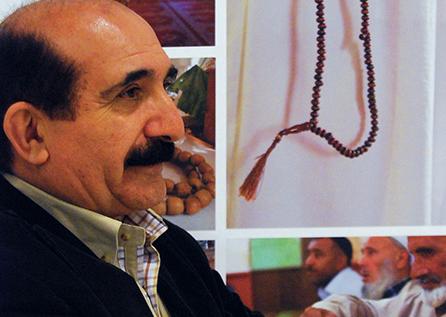
A. Kadir Ekinci was born in Kars. He graduated from Ankara Gazi Institute of Education. He has been working in a public institution as a manager. He started photography in 1992 in AFSAD (Ankara Photography Artists Association). He took part in executive and advisory boards. He also took part in many projects organized by AFSAD like GAP.
He had two personal exhibitions named “SessizIşık” (Silent Light) and “UzakIşık” (Distant Light). Many photographs taken by him were exhibited in the competitions both at home and abroad. Since he started photography, he believed in the power of light. He went after the powerful but quiet light filtered from the roof of the house in the village he was born. This was the origin of his exhibition named Silent Light. He went on collecting lights. Perhaps it was because he was afraid of darkness. As he felt himself freer and more secure with the light he pressed the shutter button with the hope of recognizing the life as it is, getting into the life and overcoming it and defeating the darkness.
Dreaming a life full of light, he wants to keep going his journey which began with Silent Light and Distant Light with the light until his way is lighten. -
ASUMAN ERGÜNEY
×ASUMAN ERGÜNEY

She was born in Ankara, in 1976. He started photography in 1997 at Hacettepe University and has continued at AFSAD since 1998. She worked in various documentaries and photography workshops and projects under the umbrella of AFSAD. She served on the Board of Directors of AFSAD. She has participated in various group exhibitions.
She still continues to take photos in some documentary projects. -
AYNUR ÜLKER
×AYNUR ÜLKER
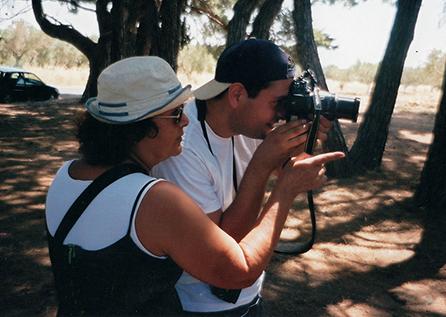
She attended 19th term training seminar of AFSAD in 1986. During the seminar she received support from Selçuk Büyükdereli member of the association about dark room study and bilateral shooting. She joined Eren Özerdim’s portrait group. She learned about cyber-printing with the help of Adnan V. Kuvanlık and Merter Oral who passed away at a young age. She made collage work with Alper Fidaner. She is still learning how to read photos because she believes that artist’s statement is hidden in every photo frame. She did not choose to bring far to close. She chose to closwr the far. She tried to maintain her education by participating in association’s activities and taking part long term in various units of Management Association.
She joined Müneher Völksochschul in order to strengthen her perspectives in photography between 1986 and 1987 and took lessons on Exhibiting – Catalogue. She continued to send photos on request until 1990.
She took place in Turkish Bath with Photos, black-and-white photo exhibition in 1994, in Utrecht, the Netherlands.
In 1991, she attended great walk of Zonguldak Mine Workers that took three days personally and held demonstrations across the country.
Between 1989-1990 she took part in Ankara Gas Plant Function Completion Documentary as Association group work. She has continues her personal Works on this issue and made some demonstrations.
In 1989 she served in a project called “Suya Özlem (Longing of the Water)” that was organized by the partnership AFSAD and Akpınar Group. Then she took part in the photography work of documenting the region which is organized by AFSAD and the GAP Regional Development Administration that continued intermittently until 2002.
In addition, she received training in the field of Turkish Handicrafts (miniature, illumination, tiles, paper marbling) long-term; she has participated in group exhibitions. She still continues to work. -
DİLEK BAL
×DİLEK BAL

She was born in Hekimhan, Malatya. She lives in Ankara. In 1999 she became a member of AFSAD. She worked as Responsible Member of AFSAD Education Department, Course Board Member and Board of Directors Member. She served in the Editorial Board of BulletenKontrast published by AFSAD. She participated in many group exhibitions organized by AFSAD as well as annual exhibitions. She took place in the project group of a long-term study and photo exhibition named “Yaşayan Halk Ozanları” (Living Minstrels).
Violence Against Women; "Traditional Photography Exhibitions" organized by Ankaralı Gezginler Grubu in order to support LÖSEV are some of her social responsibility project studies. Her photos exhibited within the contests she joined. Her photography works continue. -
DOĞANAY SEVİNDİK
×DOĞANAY SEVİNDİK

“He was about ten years old. He wanted to have taken a photo with his friends in neighborhood. Because he didn’t have money, photographer didn’t take his photo. He remembers that day with grief…” He thinks that this event connected him with photography...
He was born in Ankara, Ayaş, Dastarlı Village in 1961. He graduated from Gazi University, Faculty of Economics and Administrative Sciences, Department of Banking in 1986. He is an insurance agent.
He started photograpy in 1977. He received photography training in AFSAD, in 1984. In 1990 he became a member. In 1991-93 and 2000 period he was a member of the Board of Directors. He took part in Advisory and Photo Evaluation Committee.
Personal exhibitions: 1998 -“Sanatçı Portreleri-1“ (Portraits of Artists-1), 1999 -” Değişen Yüzler-1” (The Changing Faces-1), 2007 -“Fotoğrafta 30.Yıl” ( the 30th Anniversary in Photography).
He has attended many group exhibitions and also he performed personal exhibitions. He became a member of the jury. His photos were published in newspapers and magazines. He received 22 awards in national photo contests and his 73 photos were exhibited.
On 07.08.1994 he got married to Nalan YILMAZ, a member of AFSAD. Their marriage ceremony turned into a photo feast. The couple opened a joint photography exhibition in the wedding hall. He organized a contest for the wedding photographs taken during marriage ceremony. It was the first Wedding Photo Contest held in Turkey.
In 1998 he was awarded Honor Award Association for his contributions to the art of photography by Alumni of Banking and Insurance High School.
He was given the Special Jury Award by Art Institute of Plastic Arts in the year of 2004-2005.
In 2006, was awarded “The Most Participating Photographer in 10 Years” plaque in the Nature Shoot Contest of DASK-DOGAY and in 2012 he got "10 Years and Over Participants" plaque.
He was the originator, leader and publishing manager of the photo catalog project named “Türkiye Fotoğraf Sanatı’nda Yitirdiklerimiz 1923-2010” (Lost Ones in Turkish Photography Art 1923-2010). This catalog published in 2011 was the first photo catalog published as a campaign in Turkey. With this work, Sevindik was awarded a plaque by AFSAD and Türkiye Fotoğraf Sanatı Federasyonu (Photographic Arts Federation of Turkey). -
EROL BÜYÜKYAZICI
×EROL BÜYÜKYAZICI
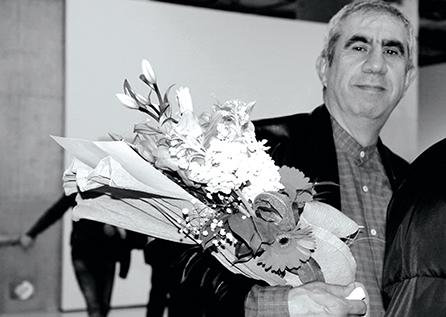
He was born in Ankara, in 1955. Although he was interested in photography before his intense interest started in 1989 when he became a member of AFSAD. As well as participating exhibitions organized by the Association he also took part in various positions.
In 2011, he opened his exhibition “Bir” (One) in İstanbul and Ankara.
Other than photography, he is also interested in short films; he shot a short film named “Bir Cumartesi Günü” (A Saturday)
His photography works are generally on thematic issues. -
GÜLSER GÜNAYDIN
×GÜLSER GÜNAYDIN

She was born in Trabzon, in 1970. She graduated from Faculty of Medicine in 1992 and from the expertise of Anesthesiology and Reanimation in 1997. She was interested in photography when she was a university student.
Her training began with basic photography and darkroom photography in AFSAD and continued with many seminars, courses, workshops and working in project teams. In 1994 she became a member of AFSAD. Under the umbrella of AFSAD he served as AFSAD Board Member, Head of Association for 4 terms, AFSAD GAP Photography Project Team member, AFSAD and Krzysztof Gieraltowski Workshop arranging team member, AFSAD 13th National Photo Exhibition Organizing Committee member, AFSAD 6th Photo Symposium Organizing Team member, “KültürdenYansıyanFotoğraflar - Ben ve Öteki -” (“Cultural Reflections in Photography - Me and the Other-” Seminar).
She wrote many articles about photography for magazines such as;
AFSAD 6. Fotoğraf Sempozyumu Hakkında Birkaç Söz (A Few Words About AFSAD 6th Photography Symposium), Fotoğrafya Sayı 15; Fotoğraf Dernekleri (Photography Associations), Fotoritim Panel Caption; Fotoğraf Yarışmaları (Photography Contests), Fotoritim Panel Caption; Fotoğraf Eleştirmenliği (Photography Criticism), Fotoritim Editorial Compile Text.
She attented many group exhibition, took part in projects and joined evaluation teams. For example:
AFSAD 13th National Photo exhibition participation; AFSAD 14th National Photo exhibition participation; Paramedics Painters and Photographers Exhibition, 2002; GAP Women’s and Children’s Photography Exhibition; Photographer without Borders Group Photography Exhibition; Jury Membership of “YaşlanmakFakatİhtiyarlamamak” (Aging but not getting older) National Photography Contest; Photography and Story Catalogue of “FotoğrafaYolculuk 40 fotoğraf 40 yazar” (Journey to Photography 40 photos 40 writers); AFSAD 25th Anniversary Photo Exhibition –“Doksanbeş100seksen”; Kompozit Workshop Photo Exhibitions; AFSAD Annual Exhibition – Yalnızlık (Loneliness). Presently, she continues writing and producing on photography as well as thinking and learning about theory and philosophy of photography. -
İBRAHİM GÖĞER
×İBRAHİM GÖĞER

He was born in 1960. He graduated from Gazi University, Institute of Education and the Faculty of Economics. He started photography studies in AFSAD (1981). He served as Member and Head of Board of Directors and member of Advisory Board and the Editorial Board. He took part in photography symposium organizations. He worked in workshops and serves ad jury member. He joined group exhibitions, made various photography presentations and gave speeches. He has published articles in various media. Göğer, who works in conceptual form opened personal exhibitions such as “CFC”, “Gıyabında (In The Absence Of)”, “Polaroid Kadınlar (Polaroid Women)”, “Red (Rejection)”, “Telden Şeyler (Things Made of Wire)” and “Blackbrush”. Besides photography he is interested in sculpture. For more information about Göğer who continues professional photography and graphic artwork at Artcamera, please visit him at www.ibrahimgoger.net.
-
MEHTAP YILDIZ
×MEHTAP YILDIZ
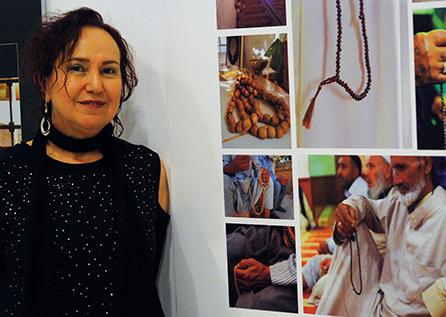 After graduating from Gazi University Faculty of Communication, she worked as a professional in the field of public relations and communications. She served as manager and consultant in various public and private institutions. Her photographic adventure started in 1983 when she attended AFSAD courses. In 1986 she became a member of the association.
After graduating from Gazi University Faculty of Communication, she worked as a professional in the field of public relations and communications. She served as manager and consultant in various public and private institutions. Her photographic adventure started in 1983 when she attended AFSAD courses. In 1986 she became a member of the association.
She served as the Board Member, Press-Public Relations Officer, FOTOGRAF Journal Editorial Board Member, Public Relations and Publicity Coordinator, Vice President, President (two terms), Advisory Board Member, Photo Review Board member, Documentary Photography Workshop Instructor, Basic Photography Training Seminar Instructor. She also took part in the selection committees in various organizations.
She joined AFSAD National Photographic exhibitions, national and international solo and group slide shows and group photography exhibitions.
In 1989, she joined the photography exhibition ”Suya Özlem (Longing of the Water)” organized by the partnership of AFSAD and Akpınar Group of Companies performing the construction of Atatürk Dam, Urfa irrigation tunnels.
In 1990, she participated “Gas Plant Function Completion Documentary (Ankara Havagazı Fabrikası’nın İşlevini Tamamlaması)”photography exhibition studies organized by Ankara Metropolitan Municipality and AFSAD.
In 1991, she worked in the photography exhibition held in Turkish Export Products Fair opened in Alma-Ata, Kazakhstan to promote the AFSAD and Turkish photography.
She was the organizer of the exhibition “Kadınca Hamam (Womanly Bath“ opened jointly with municipality of Utrecht in Utrecht, the Netherlands in 1993. She also attended the exhibition as a photographer and AFSAD representative.
Again in 1995, she was the organizer of the exhibition “Memleketimden İnsan Manzaraları (Human Landscapefrom My Homeland)” prepared by AFSAD, in Utrecht, the Netherlands and attended this exhibition as a photographer and AFSAD representative.
Between 1995-2013 she attended photography works organized by the cooperation of AFSAD and South East Anatolia (GAP) Regional Development Administration; “Bir Fırat Öyküsü (A Tale of Euphrates)”, “Sözümüz GAP Üstüne (Our Word is on GAP)”, “GAP’ta Kadın ve Çocuk (Woman and Child at GAP)”, “GAP’ta 10 Yıllık Birikim (Ten Years of Accumulation in GAP)” as an active photographer and she was the Project manager of “GAP’ta Kadın veÇocuk (Woman and Child at GAP)” photography exhibition.
In 2007, she photographed the projects organized by the cooperation of Province of Van and EU in the Region within the DAKP- Eastern Anatolia Development Program. She also became photographic consultant for the books and journals prepared for the promotion of the Project.
In 2010, she was one of the guests who went to People’s Republic of China as a representative of AFSAD and joined the group exhibition with her photos, she presented a solo slide show there.
Her life goal is to travel to different geographies, different cultures, to make new discoveries in human essence, to share and to become a citizen of the world... -
MUSTAFA ERTEKİN
×MUSTAFA ERTEKİN
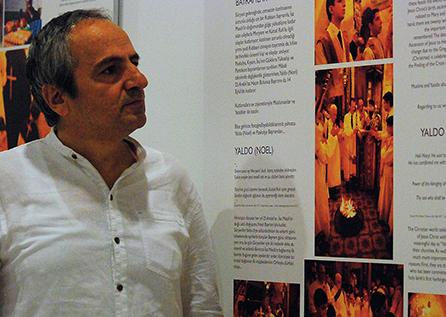 Mustafa Ertekin is a member of AFSAD since 1994 and he is also a member of the Board of Directors between 1994 and 1996. Ertekin who has various responsibilities within AFSAD, took part as a photographer and project manager between 1995-2000 in the GAP-AFSAD Projects.
Mustafa Ertekin is a member of AFSAD since 1994 and he is also a member of the Board of Directors between 1994 and 1996. Ertekin who has various responsibilities within AFSAD, took part as a photographer and project manager between 1995-2000 in the GAP-AFSAD Projects.
A photo instructor, photo safari guide and freelance photographer Mustafa Ertekin is the President of the Executive Board of AFSAD since 2011. -
NUREDDİN ÖZDENER
×NUREDDİN ÖZDENER

While he was trying to answer questions like “Who is he? What is his purpose in life? What and why does he do? So far, what has he done? What is he going to do?” Paulo Coelho whom he knows from Alchemist rescued him: ’’Everyone needs to fulfill a personal legend. Others to support you, to criticize, ignore or tolerate you is not important. You do this because it’s your destiny and source of happiness in the world.’’
“The cross on the priest’s collar,
The crescent on the top of Ulu Mosque
A grain of wheat in Mesopotamia
A broken chickpea in DavutSelim
The almonds between the ribs on the plate...
Walking in the city at night
Me against ship at sea at night
On one of my ears reyhani
On the other EminArabani
On my lips words of Akif
My camera around my neck
In my bag my stethoscope, sphygmomanometer
The source of my passion Mardin, my love of people and the world ...”
NureddinÖzdener was born in Mardin, in 1969. He studied primary, secondary and high school there. Between 1987 and 1993 he studied medicine at University of İstanbul Cerrahpaşa Medical School. He was a student of Prof. BERKARDA. He worked as a medical doctor in Mardin for 8 years. He took photos and documented them. He made demonstrations. He exhibited his photos. He became a member of AFSAD first and then AFAD. He took part in AFAD executive board.. He didn’t accept impossibilities as an excuse. He went to Cambridge, Johns Hopkins.
He is married to Olga Eker ÖZDENER and father of Efe and Elifnaz.Photography is a life style for him.
-
ORHAN KÖSE
×ORHAN KÖSE
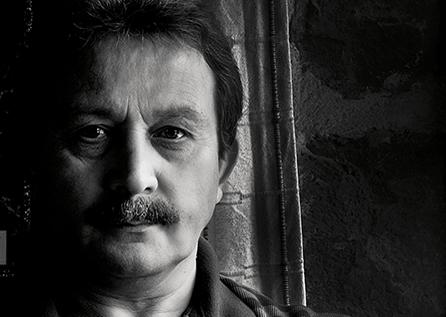
He was born in Ankara, in 1961. After completing high school he started to work as a chemical technician in various institutions. He took his first art education in Ankara Painting and Sculpture Museum. Then he attended the Azeri descended painter MövsümOruçov’s workshop. His interest in photography started through his brother Ali Köse. He has attended basic training, DoğanaySevindik documentary workshop and sun printing workshop. He took part in group exhibitions in AFSAD. He has studies on charcoal workers, metal workers, urban transformation, and rural life.
-
ÖZCAN YURDALAN
×ÖZCAN YURDALAN

He was born in Adana in 1955. He was among the founders of AFSAD (Ankara Photography Artists Association) in 1977. He worked in DİSK-General Workers’ Union Photo Film Center until 1980. After 1999 Marmara Earthquake, he worked in Photographer Children Workshop which was organized by Solidarity Volunteers. He was among founders of FV (Photograph Foundation) in 2000 and he was among founders of Nar Photography Agency in 2005.
He is a travel writer and writes articles in various magazines and newspapers. He is going on long journeys.
PUBLISHED BOOKS
1. Ahşap Fanus - İran Yolculuğu - Sarı Otobüs 1 - Agora Kitaplığı, İstanbul 2005
2. Mavi Çöl - Pakistan Yolculuğu - Sarı Otobüs 2 - Agora Kitaplığı, İstanbul 2005
3. Namaste - HindistanYolculuğu - Sarı Otobüs 3 - Agora Kitaplığı, İstanbul 2007
4. Sagarmatha Eteklerinde - Nepal Yolculuğu - Sarı Otobüs 4 - Agora Kitaplığı, İstanbul 2005
5. Naure Çarkı - Suriye Yolculuğu - Sarı Otobüs 5 - Agora Kitaplığı, İstanbul 2006
6. Belgesel Fotoğraf ve Fotoröportaj - Agora Kitaplığı, İstanbul 2007
7. Atların Denizi - Moğolistan Yolculuğu Sarı otobüs 6 - Agora Kitaplığı, İstanbul 2009
8. Bir Seyyahın Kaybolma Kılavuzu - Yolcular İçin El Aynası 1 - Agora Kitaplığı, İstanbul 2010
9. Magrip En Uzak Batı - FasYolculuğu- Sarı Otobüs 7 - Agora Kitaplığı, İstanbul 2013
PUBLISHED BOOKS AS A CO-WRITER
Sefername I - Der: Orhan Kural, Gezginler Kulübü Yay. İstanbul 2000
Sefername II - Der: Orhan Kural, Gezginler Kulübü Yay. İstanbul 2003
Sahibini Arayan Barış - Der: Masis Kürkçügil Everest Yay. İstanbul 2002
Habercinin El Kitabı - Der: Sevda Alankuş Gazetecilik ve Habercilik İPS İletişimVakfı Yay. İstanbul 2003
Çocuklarla Fotoğraf (Mehmet Kaçmaz ile birlikte) FV yayınları, İstanbul 2004
Yedi Deniz Beş Bucak - Gezi Edebiyatı Seçkisi - (Der: AlpayKabacalı) - Dünya Kitapları İstanbul 2004
Merhabarev - İstanbul - Erivan (Fotoğraf Albümü) Nar Kitapları, İstanbul 2006 (with Mehmet Kaçmaz, TolgaSezgin, KeremUzel, Serra Akcan, Ruben Mangasaryan, Anahit Hayrapetyan, Nelli Shismanyan, German Avagyan, Karen Mirzoyan) -
SELİM AYTAÇ
×SELİM AYTAÇ
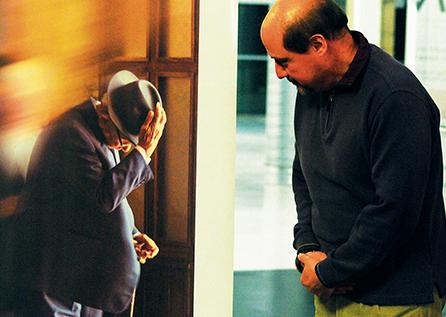
He was born in Zonguldak in 1961. He graduated from the Middle East Technical University, Department of Economics in 1983. He has been continuing his photography studies as an amateur since 1988. On 24thof December 1991, he became the member of AFSAD (Ankara Photography Artists’ Association) whom he met in 1990. He was the member of the Executive Board in AFSAD in 1992-93 terms. He served on the board of organization in the 4thPhotography Symposium (1992) organized by AFSAD. He served as a member of the Executive Board of the Photographic Arts Federation of Turkey (TFSF) from 2007 to 2013. Also, he served in the organization of the photography contests called “Nature Shoot out Contest (Doğada Fotoğraf Avcılığı/DOGAY)” which is held first in 1995 by “Nature Research and Sports Club (Doğa Araştırma ve Sporları Kulübü/DASK)” to reveal natural beauties all over the country.
In 1998, he opened a personal exhibition named “Ayrıntı (Detail)”.
He took part in the exhibitions called “Bir Fırat Öyküsü (A Tale of Euphrates)” (1995), “Sözümüz GAP Üstüne (Our Word is on GAP)” (1996), “GAP’ta Kadın ve Çocuk (Woman and Child in GAP) (1997)”, “Fırat’a Karışan Hayat, Hayata Karışan Fırat (Life Merging to Euphrates, Euphrates Merging to Life)” (1998) and “GAP’ta 10 Yıllık Birikim” (Ten Years of Accumulation at GAP) (1999) organized by the cooperation of AFSAD and Southeastern Anatolia (GAP) Regional Development Administration to document the visual change in the region. He also attended in “Just Photograph of It” exhibition which aimed to take attention the disaster caused by the earthquake occurred on 17th of August and 12th of November in 1999.
The study called “A Quarter in Ankara” (Ankara’da Bir Mahalle) was exhibited in 2004, which was the first product of AFSAD Documentary Workshop that he conducted with Serpil Yıldız. The second project of this Workshopwas “Me Romis Sinom (‘I’m a human’ in Romani language)". After a five year study, the exhibition opened in 2011. He has attended various exhibitions and won awards in various national and international competitions. He mainly worked reversal film before digital photography technology. -
SERPİL YILDIZ
×SERPİL YILDIZ
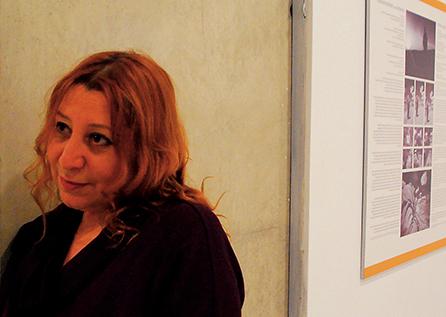 Her interest in photography began at the end of the 80’s. She volunteered to prepare the “Image” newsletter and other miscellaneous activities in AFSAD. In this period, she was only a photo viewer. She is interested in taking photograph in 1991 and became the member of AFSAD in 1994. Starting from 1994, in AFSAD, she served as a member of Organization Board in various symposiums and activities; as a member of Executive Board (4 terms); as a participant photographer and the project manager in AFSAD-GAP Projects; AFSAD President (2 terms) and as representative of Advisory Board, Photography Evaluation Board and Study Group of Turkish Photography Associations. She participated in AFSAD National Photography Exhibitions, various documentary studies, national and international group exhibitions and slide shows; also presented personal slide shows. She took part in many group exhibitions: “Poster Photographs” exhibition was dragging attention for the usage of photograph out of its main purpose; “Waiting…”, “Lives of Refugees” were presenting the problems of refugees. Apart from these, she personally presented lots of slide shows: “Van Bien” (They’re Going Well) Cuba Exhibition (İstanbul, Adana, Halfeti); many slide shows on Cuba with various themes like “May 1st in Havana (Havana’da 1 Mayıs)”. She is also co-writer of the book “Cuba, A Yellow Hot Window” (Küba, Sarı Sıcak Bir Pencere).
Her interest in photography began at the end of the 80’s. She volunteered to prepare the “Image” newsletter and other miscellaneous activities in AFSAD. In this period, she was only a photo viewer. She is interested in taking photograph in 1991 and became the member of AFSAD in 1994. Starting from 1994, in AFSAD, she served as a member of Organization Board in various symposiums and activities; as a member of Executive Board (4 terms); as a participant photographer and the project manager in AFSAD-GAP Projects; AFSAD President (2 terms) and as representative of Advisory Board, Photography Evaluation Board and Study Group of Turkish Photography Associations. She participated in AFSAD National Photography Exhibitions, various documentary studies, national and international group exhibitions and slide shows; also presented personal slide shows. She took part in many group exhibitions: “Poster Photographs” exhibition was dragging attention for the usage of photograph out of its main purpose; “Waiting…”, “Lives of Refugees” were presenting the problems of refugees. Apart from these, she personally presented lots of slide shows: “Van Bien” (They’re Going Well) Cuba Exhibition (İstanbul, Adana, Halfeti); many slide shows on Cuba with various themes like “May 1st in Havana (Havana’da 1 Mayıs)”. She is also co-writer of the book “Cuba, A Yellow Hot Window” (Küba, Sarı Sıcak Bir Pencere).
Her photographs have been published in many newspapers and magazines so far. She worked as a science writer in TÜBİTAK Science and Technology Magazine and NTV Bilim (Science Magazine) and wrote articles on photography at the same time.The study called “A Quarter in Ankara” (Ankara’da Bir Mahalle) was exhibited in 2004, which was the first product of AFSAD Documentary Workshop that she conducted with SelimAytaç. The second project of this Workshopwas“Me RomisSinom (‘I’m a human’ in Romani language)". After a five year study, the exhibition opened in 2011. SerpilYıldız, who has never participated in a photography contest until now, usually takes social documentary, documentary and rarely experimental photographs. As the Hacettepe University graduate, Physics Engineer Serpil Yıldız has been dealing with freelance science authorship, editorship, photography and photography training and currently working as a lecturer at Atılım University.
EXHIBITION HALLS
INSTITUTIONS
AFSAD will have been dealing with Southeastern Anatolia Region for 25 years in June 2014. AFSAD has been this region for quarter-century and it is writing the story of the change coming with the GAP, which is the biggest project in Turkey and one of the most special projects in the world, with documentary photographes . The first step on this road was taken with the support of Akpınar A.Ş in 1989. “SuyaÖzlem” (Craving for Water) was our first exhibition. The cooperation with the Presidency of GAP Regional Development Administration started in 1995. This gave AFSAD the opportunity to prepare a long-term documentary study. The documentary witness which started again with “Bir Fırat Öyküsü” (“A Story of Euphrates”) that year, continued and was enrichedwith “Sözümüz GAP Üstüne” (“It’s All About GAP”), “GAP’ta Kadın veÇocuk” (“Woman and Child in GAP”), ’’Fırat’aKarışan Hayat, HayataKarışanFırat’(“Life by Euphrates, Euphrates by Life”) and “GAP’ta 10 Yıllık Birikim” (“Ten Years’ Experience in GAP”) such that it won the “Sanat Kurumu Özel Ödülü” (The Institution of Art Special Award).
The study of “Faiths and Beliefs in South East Anatolia” is AFSAD’s sixth study which has been carried out with the support of the GAP Regional Development Administration and it is seventh study in the region. The project lasted for a 13-year period due to the very hard working conditions and obstacles and its theme and therefore; it has been the longest-running project of AFSAD.
This book you hold in your hand is not only a new indication of our service we have been doing for the art of photography and the society in this country for 37 years but also a new and very important step in order to transfer the history to the future.
Yes. AFSAD is celebrating its 37th year as a non-governmental organisation in the field of photography. It is a journey with full of symposiums, journals, publications, photography discussions, educations, exhibitions, demonstrations, meetings and many more events that leave mark...
We wish to meet again in further projects.
Mustafa Ertekin
President
AFSAD
The first important activity of AFSAD was in 1978 when the association organized a meeting on the “Function of the Art of Photography in Turkey”. This first meeting pioneered AFSAD Photography Symposiums that became a conventional event later. AFSAD so far organized 7 National Symposiums.
For its 37 years long activities, AFSAD has become a “school” in its field. Its activities include training seminars at various levels; meetings organized to contribute to theoretical and philosophical issues related to photography; national and international level exhibitions; communication and publication activities in the field; social activities and seminars in script writing, short documentaries and history and philosophy of arts.
AFSAD has many publications as well. The periodical “Photography” had its 57 issues in the period 1978-1993. Its recent periodical “Contrast” presently has 39 issues.
The 16 National Exhibition organized with the contribution of all photographers stands as an inventory of the values and problems of the country.
The AFSAD cooperates with public, private and civil society organizations at national and international level in line with its mission. It has long engaged with the Prime Ministry GAP Regional Development Administration in photography projects and exhibitions; “Training in Photography for the Disabled” with the World Bank; photo exhibition on the theme “Voluntary Commitment” with the EU; “Working Children National Exhibition” with ILO; “Ankara Documentary” with the Ministry of Culture and Tourism; “Photography Training in Reformatories” with the Ministry of Justice; “Yes to Arts” with TOBAV and “Van Earthquake” with TFSF.
Celebrating its 37th year, the AFSAD continues its mission in photography as a civil society organization.
Studies for development of the Southeastern Anatolia Region have been continuing in terms of maintaining active participation of individuals in economic and social life with economic growth, raising their life quality and increasing social solidarity and integration. GAP is founded on the philosophy of sustainable human development for next generations in which they will be able to improve themselves. Through GAP which is known as irrigation, energy and infrastructure project, development and improvement are defined with parameters such as average life expectancy, infant mortality, literacy rate, time for participating in education, health services accessibility, welfare differences between regions and sexes and quality of life and its sustainability.
While the Presidency of GAP Administration, as a visionary organization, has been running the Southeastern Anatolia Project, it believes that deeply rooted cultural and artistic richness in the region contribute to the efforts for development. So GAP Administration spreads on effort to transform the region into an art land and to promote artistic dialog as it has already deserved. For this purpose, in the Southeastern Anatolia Region, projects have been conducted for maintaining and improving cultural richness and diversity and strengthening cultural infrastructure as well as generalising the artistic and cultural activities.
The GAP Administration has been working in cooperation with Ankara Photography Artists Association (AFSAD) since 1995. Until now, many valuable photographers from the association have taken the photographs of the change in the region with the project and organized many important exhibitions.
The Project of Beliefs and Faiths in Southeastern Anatolia, which targets to present the diversity of spiritual life in the past and present; the richness of religious traditions that share many common values in Southeastern Anatolia, is based on a partnership that have been spread over many years between two institutions. With this important documentary study, the ability of living together in a region, which has a multi-cultural structure and spiritual richness, by respecting and understanding different beliefs, is emphasized.
I present my thanks to the photography artists who interpret the extant religious traditions, friendship of diversities, tolerance and togetherness in different angles. I also thank to AFSAD and to our Administration staff for their meaningful and productive efforts.
Sadrettin KARAHOCAGİL
President, GAP Administration
At the outset, the GAP was a programme focusing on the development of land and water resources of the region, envisaging the construction of 22 dams and 19 hydraulic power plans on the rivers Euphrates and Tigris and introducing irrigation to 1.8 million hectares of land. In 1989, with the GAP Master Plan introducing a new vision, the GAP also included investments in such diverse fields as agriculture, industry, transportation, education, health and rural and urban infrastructure building. At present, it is implemented as a regional development project based on sustainable human development.
First starting with the idea of utilizing region’s rich water and land resources, the project then transformed into a multi-sector and integrated programme that comprises all components of development. This new vision naturally made it necessary to follow and direct investments in different sectors that complement and lay the ground for each other and also to ensure coordination among organizations engaged in these investments.
The Presidency of GAP Regional Development Administration was established on 6 November 1989 covering the provinces of Adıyaman, Batman, Diyarbakır, Gaziantep, Kilis, Mardin, Siirt, Şanlıurfa and Şırnak where the SoutheasternAnatolia Project is implemented. For the rapid development of the region and realization of envisaged investments, the mission of the administration includes services in planning, infrastructure building, licensing, housing, industry, mining, agriculture, energy and transportation; adoption of measures to raise the education level of local people and ensuring coordination among relevant organizations and agencies.
The Presidency of GAP Administration adopts a specific approach to regional development that is based on principles of economic, social, environmental and cultural sustainability. Participation is the precondition of all relevant activities. The Administration is aware of the fact that the cooperation of governmental agencies, private sector and civil society organizations is essential for ensuring sustainable human development. All projects and activities including those related to agriculture, renewable energy, social projects, environment, tourism, protection of cultural assets and improvements in infrastructure take place in line with this overall approach.
PRESS ROOM
| Date | Broadcast | New Name |
| 28.01.2014 | PİRSUS HABER | Güneydoğu İnsanının İnançlarını Fotoğrafladılar |
| 26.01.2014 | HABER 3 | “Güneydoğu’da İnançlar-İnanışlar” Fotoğraf Sergisi |
| 25.01.2014 | MYNET TV | “Güneydoğu Anadolu’da İnançlar ve İnanışlar” Fotoğraf Sergisi - ANKARA |
| 28.01.2014 | SABAH | Amin/Amen sergisi Cer Modern’de açıldı |
| 26.01.2014 | OBJEKTİF HABER | Güneydoğu İnsanının İnançlarını Fotoğrafladılar |
| 25.01.2014 | PLATİN HABER | “Güneydoğu Anadolu’da İnançlar Ve İnanışlar” Fotoğraf Sergisi |
| 26.01.2014 | HABER UFKU | Güneydoğu insanının inançlarını fotoğrafladılar |
PHOTO EXHIBITION in İSTANBUL
“FAITHS and BELIEFS in SOUTHEAST ANATOLIA”
The photo exhibition “AMİN-AMEN” organized jointly by the GAP Regional Development Administration and AFSAD – Ankara Photography Artists’ Association – focusing on beliefs and faiths in Southeastern Anatolia will be receiving visitors in İstanbul starting from Wednesday, December 3rd 2014.
Many photography fans and guests will be present at the opening ceremony of the exhibition at Taksim Cumhuriyet Art Gallery of Istanbul Metropolitan Municipality (İBB). Prior to the opening ceremony, the Marmara Hotel will host a 45-minute long multimedia show bearing the same name with the exhibition.
PROJECT WITH A HISTORY OF 13 YEARS
This will be the sixth activity of the AFSAD realized with the support of the GAP Regional Development Administration and seventh of a series held in the region. So with its history of 13 years now, the project “Faiths and Beliefs in SouthEast Anatolia” is one of the longest-breathed photography activities in Turkey. The exhibition will include photos by members of Ankara Photography Artists’ Association photographers including A. Kadir Ekinci, Asuman Ergüney, Aynur Ülker, Dilek Bal, Doğanay Sevindik, Erol Büyükyazıcı, Gülser Günaydın, İbrahim Göğer, Mehtap Yıldız, Mustafa Ertekin, Nureddin Özdener, Orhan Köse, Özcan Yurdalan, Selim Aytaç and Serpil Yıldız. 104 panels will display 758 photographs in total.
With Serpil Yıldız as the project manager and İbrahim Göğer as the curator, the first exhibition of this documentary photography project opened in Ankara, CerModern Exhibition Hall from January 24 to February 9 2014.
The “Amin-Amen Photo Exhibition” will be open to visitors between December 3 – 16, 2014 at the Taksim Cumhuriyet Art Gallery of the İBB from 10.00 to 19.00 every day except on Sundays.
Multimedia Show: THE MARMARA HOTEL, Taksim Square, Beyoğlu/İstanbul; December 3, 2014 Hour: 18.30
Opening Reception and Cocktail: İBB TAKSİM CUMHURİYET ART GALLERY (MAKSEM) İstiklal Caddesi No: 2 Taksim, Beyoğlu/İSTANBUL; December 3, 2014 Hour: 19:30
| Date | Publisher | Title |
| 12.12.2014 | AGOS GAZETESİ | Gazete küpürünü görmek için tıklayınız |
| 05.12.2014 | BİZİM ANADOLU GAZETESİ | Gazete küpürünü görmek için tıklayınız |
| 08.12.2014 | DÜNYA GAZETESİ | Gazete küpürünü görmek için tıklayınız |
| 09.12.2014 | HİZMET GAZETESİ | Gazete küpürünü görmek için tıklayınız |
| 08.12.2014 | HÜRRİYET GAZETESİ | Gazete küpürünü görmek için tıklayınız |
| 02.12.2014 | TARAF GAZETESİ | Gazete küpürünü görmek için tıklayınız |
| 11.12.2014 | TİCARİ HAYAT GAZETESİ | Gazete küpürünü görmek için tıklayınız |
GUEST BOOK
Güzel Türkiyemin güzelliklerini fotoğraf karelerinize sığdıran, ilk bakışta bize değişik gelen ve bizlerin de bunları görmesine imkan sağlayan siz değerli fotoğraf sanatçılarına teşekkürler.
CONTACT
The Story Behind the Project
From Curator
Project Masthead
Yazidis
The Land of Prophets
Traces of Judaism
Prepresentatives of Christianity in the
Southeastern Anatolia
The Muslims are Coming
Symbols Within Life
Crossing The Borders
Weddings
Marriage Agreement
People of This Land
Cities, Markets and Bazaars
GAP
Announcements
Press Kit







